Paul van Yperen's Blog, page 317
February 22, 2017
L'Epopée napoléonienne (1903)
L'Epopée napoléonienne/Napoleon Bonaparte (Lucien Nonguet, 1903) is an early biopic by Pathé Frères. The Historic drama shows some highlights of the career of Napoléon, like the Coronation, the battle of Austerlitz, the soldier sleeping during watch, the burning of Moscow, Waterloo and the Emperor's death. Several postcard series were produced for the film, including one in France by Rex and one in Italy by the famous postcard publisher Alterocca with also French captions.

French postcard by Rex, no. 4156. Photo: Pathé Frères. Publicity still for Epopée napoléonienne (Lucien Nonguet, 1903). Caption: Napoléon blessé à Ratisbonne.
The image above was vaguely based on the painting Napoléon blessé à Ratisbonne (Napoleon hurt at Regensburg, 1810) by Pierre Gautherot. The scene depicted the only moment Bonaparte was hurt when fighting, on 23 April 1809. The painting is now at the Musée national du chateau de Versailles.
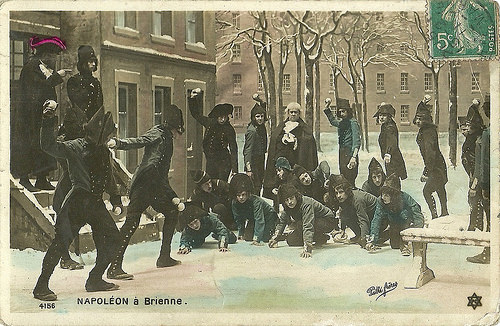
French postcard by PC, no. 4156. Photo: Pathé Frères. Publicity still for L'Epopée napoléonienne (Lucien Nonguet, 1903). Caption: Napoléon à Brienne.
The scene above depicts one of the Napoléon legends, also painted by Horace Vernet, and dazzingly staged on film by Abel Gance . Already at the military academy a young Bonaparte whould have showed his strategic leadership during a snowball fight.

Italian postcard by Alterocca, Terni, no. 4434. Photo: Cinématographe Pathé. Publicity still for L'Epopée napoléonienne (Lucien Nonguet, 1903). Caption: Napoléon à l'école de Brienne (1781).
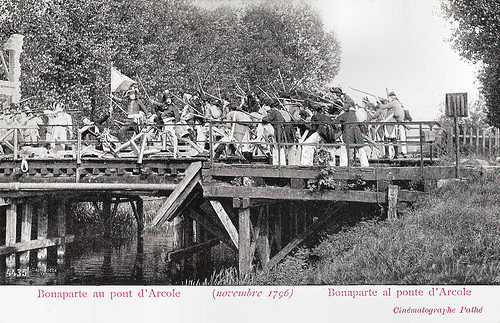
Italian postcard by Alterocca, Terni, no. 4435. Photo: Cinématographe Pathé. Publicity still for L'Epopée napoléonienne (Lucien Nonguet, 1903). Caption: Bonaparte au pont d'Arcole (novembre 1796).
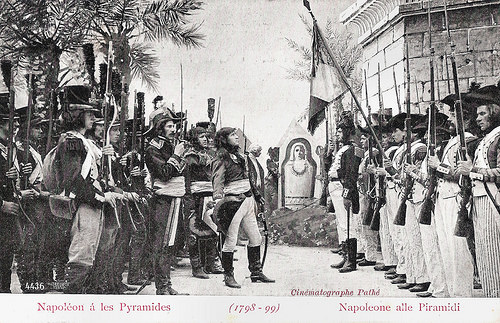
Italian postcard by Alterocca, Terni, no. 4436. Photo: Cinématographe Pathé. Publicity still for L'Epopée napoléonienne (Lucien Nonguet, 1903). Caption: Napoléon á les Pyramides (1798-99).
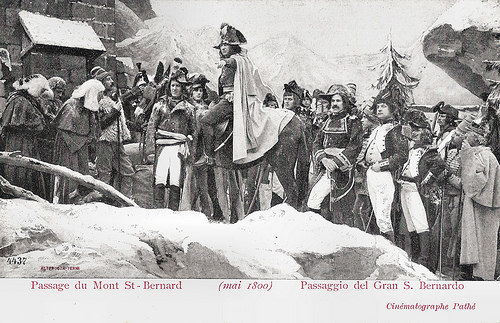
Italian postcard by Alterocca, Terni, no. 4437. Photo: Cinématographe Pathé. Publicity still for L'Epopée napoléonienne (Lucien Nonguet, 1903). Caption: Passage du Mont St.-Bernard (mai 1800).
A worldwide cultural icon
Napoléon Bonaparte (1769-8921, born Napoleone di Buonaparte, was a French military and political leader who rose to prominence during the French Revolution. He led several successful campaigns during the French Revolutionary Wars.
He was born in Corsica to a relatively modest family from the minor nobility. When the Revolution broke out in 1789, Napoleon was serving as an artillery officer in the French army. Seizing the new opportunities presented by the Revolution, he rapidly rose through the ranks of the military, becoming a general at age 24.
At age 26, he began his first military campaign against the Austrians and their Italian allies—winning virtually every battle, conquering the Italian Peninsula in a year, and becoming a national hero. In 1798, he led a military expedition to Egypt that served as a springboard to political power. He engineered a coup in November 1799 and became First Consul of the Republic. His ambition and public approval inspired him to go further.
In 1804 he became the first Emperor of the French. As Napoléon I, he was Emperor of the French from 1804 until 1814, and again in 1815. Napoleon dominated European and global affairs for more than a decade while leading France against a series of coalitions in the Napoleonic Wars.
He won most of these wars and the vast majority of his battles, building a large empire that ruled over continental Europe before its final collapse in 1815.
Napoléon has become a worldwide cultural icon who symbolises military genius and political power. One of the greatest commanders in history, his wars and campaigns are studied at military schools worldwide. Napoléon's political and cultural legacy has ensured his status as one of the most celebrated and controversial leaders in human history.
Napoléon has been portrayed in many works of fiction, his depiction varying greatly with the author's perception of the historical character. Best known is probably the classic silent film Napoleon (Abel Gance, 1927), with young general Bonaparte is portrayed as a heroic visionary.
L'Epopée napoléonienne (1903) was made by Lucien Nonguet, a former crowd-scene manager at several thetres, including the Ambigu and the Châtelet in Paris. He was specialised in actualités and historical reconstructions.
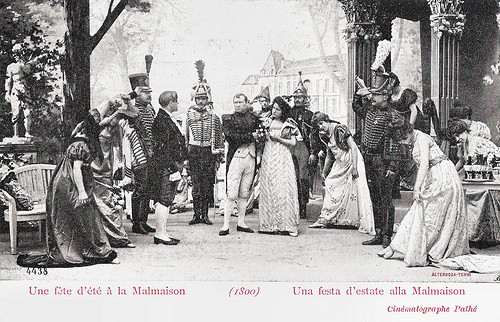
Italian postcard by Alterocca, Terni, no. 4438. Photo: Cinématographe Pathé. Publicity still for L'Epopée napoléonienne (Lucien Nonguet, 1903). Caption: Une fête d'été à la Malmaison (1800).
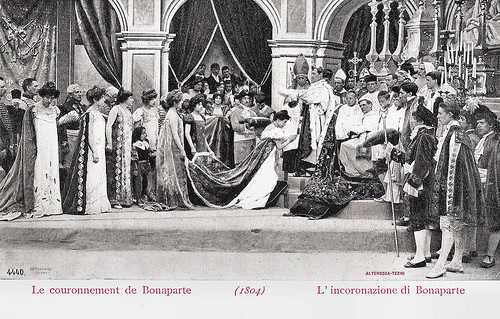
Italian postcard by Alterocca, Terni, no. 4440. Photo: Cinématographe Pathé. Publicity still for L'Epopée napoléonienne (Lucien Nonguet, 1903). Caption: Le Couronnement de Bonaparte (1804).

Italian postcard by Alterocca, Terni, no. 4441. Photo: Cinématographe Pathé. Publicity still for L'Epopée napoléonienne (Lucien Nonguet, 1903). Caption: Napoléon à Austerlitz (2 déc. 1805).
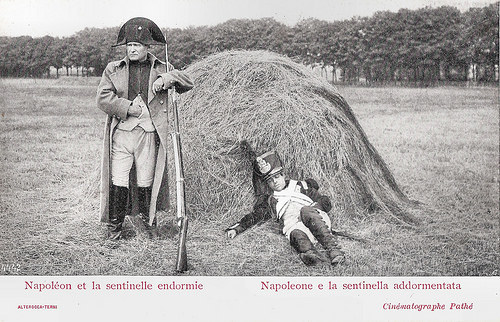
Italian postcard by Alterocca, Terni, no. 4442. Photo: Cinématographe Pathé. Publicity still for L'Epopée napoléonienne (Lucien Nonguet, 1903). Caption: Napoléon et la sentinelle endormie.

Italian postcard by Alterocca, Terni, no. 4443. Photo: Cinématographe Pathé. Publicity still for L'Epopée napoléonienne (Lucien Nonguet, 1903). Caption: Les adieux de Fontainebleau (avril 1814).
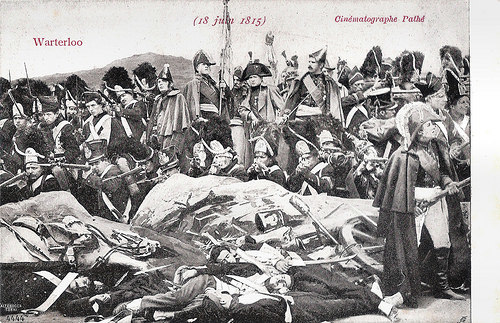
Italian postcard by Alterocca, Terni, no. 4444. Photo: Cinématographe Pathé. Publicity still for L'Epopée napoléonienne (Lucien Nonguet, 1903). Caption: Waterloo (18 juin 1815).
Sources: Richard Abel (The Ciné Goes to Town: French Cinema, 1896-1914), Wikipedia and IMDb.

French postcard by Rex, no. 4156. Photo: Pathé Frères. Publicity still for Epopée napoléonienne (Lucien Nonguet, 1903). Caption: Napoléon blessé à Ratisbonne.
The image above was vaguely based on the painting Napoléon blessé à Ratisbonne (Napoleon hurt at Regensburg, 1810) by Pierre Gautherot. The scene depicted the only moment Bonaparte was hurt when fighting, on 23 April 1809. The painting is now at the Musée national du chateau de Versailles.

French postcard by PC, no. 4156. Photo: Pathé Frères. Publicity still for L'Epopée napoléonienne (Lucien Nonguet, 1903). Caption: Napoléon à Brienne.
The scene above depicts one of the Napoléon legends, also painted by Horace Vernet, and dazzingly staged on film by Abel Gance . Already at the military academy a young Bonaparte whould have showed his strategic leadership during a snowball fight.

Italian postcard by Alterocca, Terni, no. 4434. Photo: Cinématographe Pathé. Publicity still for L'Epopée napoléonienne (Lucien Nonguet, 1903). Caption: Napoléon à l'école de Brienne (1781).

Italian postcard by Alterocca, Terni, no. 4435. Photo: Cinématographe Pathé. Publicity still for L'Epopée napoléonienne (Lucien Nonguet, 1903). Caption: Bonaparte au pont d'Arcole (novembre 1796).

Italian postcard by Alterocca, Terni, no. 4436. Photo: Cinématographe Pathé. Publicity still for L'Epopée napoléonienne (Lucien Nonguet, 1903). Caption: Napoléon á les Pyramides (1798-99).

Italian postcard by Alterocca, Terni, no. 4437. Photo: Cinématographe Pathé. Publicity still for L'Epopée napoléonienne (Lucien Nonguet, 1903). Caption: Passage du Mont St.-Bernard (mai 1800).
A worldwide cultural icon
Napoléon Bonaparte (1769-8921, born Napoleone di Buonaparte, was a French military and political leader who rose to prominence during the French Revolution. He led several successful campaigns during the French Revolutionary Wars.
He was born in Corsica to a relatively modest family from the minor nobility. When the Revolution broke out in 1789, Napoleon was serving as an artillery officer in the French army. Seizing the new opportunities presented by the Revolution, he rapidly rose through the ranks of the military, becoming a general at age 24.
At age 26, he began his first military campaign against the Austrians and their Italian allies—winning virtually every battle, conquering the Italian Peninsula in a year, and becoming a national hero. In 1798, he led a military expedition to Egypt that served as a springboard to political power. He engineered a coup in November 1799 and became First Consul of the Republic. His ambition and public approval inspired him to go further.
In 1804 he became the first Emperor of the French. As Napoléon I, he was Emperor of the French from 1804 until 1814, and again in 1815. Napoleon dominated European and global affairs for more than a decade while leading France against a series of coalitions in the Napoleonic Wars.
He won most of these wars and the vast majority of his battles, building a large empire that ruled over continental Europe before its final collapse in 1815.
Napoléon has become a worldwide cultural icon who symbolises military genius and political power. One of the greatest commanders in history, his wars and campaigns are studied at military schools worldwide. Napoléon's political and cultural legacy has ensured his status as one of the most celebrated and controversial leaders in human history.
Napoléon has been portrayed in many works of fiction, his depiction varying greatly with the author's perception of the historical character. Best known is probably the classic silent film Napoleon (Abel Gance, 1927), with young general Bonaparte is portrayed as a heroic visionary.
L'Epopée napoléonienne (1903) was made by Lucien Nonguet, a former crowd-scene manager at several thetres, including the Ambigu and the Châtelet in Paris. He was specialised in actualités and historical reconstructions.

Italian postcard by Alterocca, Terni, no. 4438. Photo: Cinématographe Pathé. Publicity still for L'Epopée napoléonienne (Lucien Nonguet, 1903). Caption: Une fête d'été à la Malmaison (1800).

Italian postcard by Alterocca, Terni, no. 4440. Photo: Cinématographe Pathé. Publicity still for L'Epopée napoléonienne (Lucien Nonguet, 1903). Caption: Le Couronnement de Bonaparte (1804).

Italian postcard by Alterocca, Terni, no. 4441. Photo: Cinématographe Pathé. Publicity still for L'Epopée napoléonienne (Lucien Nonguet, 1903). Caption: Napoléon à Austerlitz (2 déc. 1805).

Italian postcard by Alterocca, Terni, no. 4442. Photo: Cinématographe Pathé. Publicity still for L'Epopée napoléonienne (Lucien Nonguet, 1903). Caption: Napoléon et la sentinelle endormie.

Italian postcard by Alterocca, Terni, no. 4443. Photo: Cinématographe Pathé. Publicity still for L'Epopée napoléonienne (Lucien Nonguet, 1903). Caption: Les adieux de Fontainebleau (avril 1814).

Italian postcard by Alterocca, Terni, no. 4444. Photo: Cinématographe Pathé. Publicity still for L'Epopée napoléonienne (Lucien Nonguet, 1903). Caption: Waterloo (18 juin 1815).
Sources: Richard Abel (The Ciné Goes to Town: French Cinema, 1896-1914), Wikipedia and IMDb.
Published on February 22, 2017 22:00
February 21, 2017
Jackie Lane
Austrian born starlet Jackie Lane (1937) was a stunningly beautiful model and film actress of the 1950s and 1960s, who starred both in European films and in Hollywood pictures. She was married to Prince Alfonso of Hohenlohe-Langenburg.
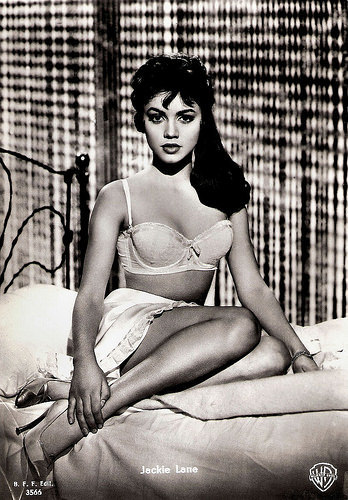
Italian postcard by B.F.F. Edit., no. 3566. Photo: Warner Bros. Publicity still for Tickle Me (Norman Taurog, 1965).
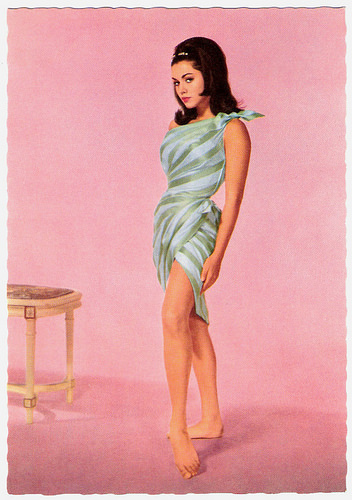
German by ISV, Sort. 11/6.
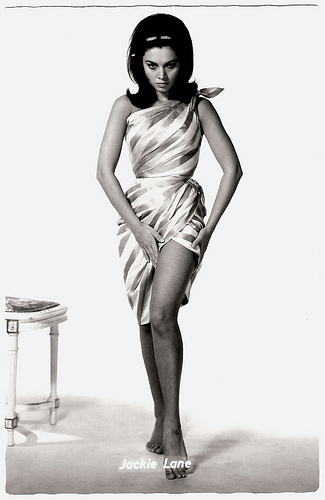
German postcard by Fred. W. Sander-Verlag, Minden / Kolibri, no. 2051.
Not above fibbing about her age
Jackie Lane was born as Jocelyn Olga Bolton in Vienna, Austria, in 1937. She is the youngest daughter of a Russian-born pianist mother, Olga Mironova, and an English father, John Bolton, who worked for an American oil firm. She was educated in New Rochelle, New York, in the United States.
At the age of 14, she moved to Britain where she received dance training. Her elder sister, Mara Lane, was a well-known British model and actress in the 1950s. Jocelyn established herself as a popular model in the United Kingdom by the time she was 18, using the pseudonym Jackie Lane.
She appeared on hundreds of magazine covers around the world. H. David Schleicher at IMDb : "Jackie was not above fibbing about her age; in a 1957 photo pictorial by Russ Meyer in Modern Man, the 20-year-old Jackie is referred to as 'Mara's 18-year-old sister'. "
From 1954 on, she acted in several British films like the travel film April in Portugal (Euan Lloyd, 1954/1956). She also appeared in the Anglo-American science fiction film The Gamma People (John Gilling, 1955) starring Paul Douglas, and the Frankie Vaughan musicals These Dangerous Years (Herbert Wilcox, 1957) and Wonderful Things! (Herbert Wilcox, 1958).
She played a supporting part in The Angry Hills (Robert Aldrich, 1959), based on the novel by Leon Uris, and starring Robert Mitchum. She also appeared in the British thriller Jet Storm (Cy Endfield, 1959), with Richard Attenborough, and the Italian adventure film Robin Hood e i pirati/Robin Hood and the Pirates (Giorgio Simonelli, 1960) starring Lex Barker .
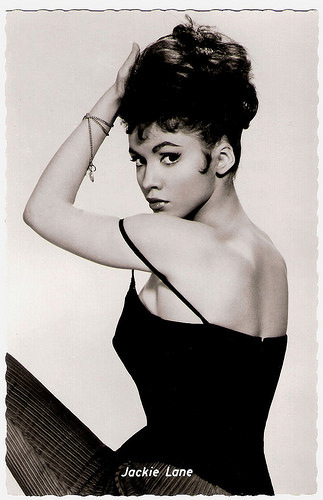
German by Kolibri-Verlag G.m.b.H. Minden/Westf., no. 1614.
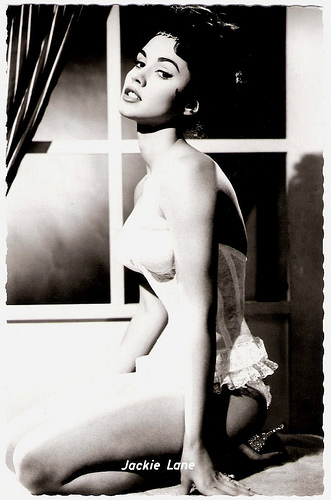
German postcard by Kolibri-Verlag G.m.b.H., Minden-Westf., no. 1266.
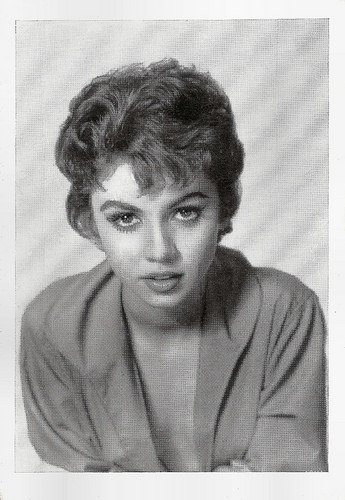
German cigarette card.
Hell's Belle
In the early 1960s Jackie Lane appeared in several European film productions. She had a supporting part in the drama Aimez-vous Brahms?/Goodbye Again (Anatole Litvak, 1961), starring Ingrid Bergman . The screenplay was written by Samuel A. Taylor, based on the novel by Françoise Sagan.
In Britain, she played in Two and Two Make Six (Freddie Francis, 1962), starring George Chakiris , and the comedy Operation Snatch (Robert Day, 1962) starring Terry-Thomas and George Sanders. In Italy she starred in the Peplums Marte, dio della guerra/Venus Against the Son of Hercules (Marcello Baldi, 1962) opposite Roger Browne, and Le sette folgori di Assur/War Gods of Babylon (Silvio Amadio, 1962), with Howard Duff.
In 1964, Lane moved to Hollywood. As she was confused with another actress named Jackie Lane (known for starring in the TV series Doctor Who), she began to be credited with her full first name, Jocelyn Lane. Her resemblance to Brigitte Bardot was widely remarked upon.
In 1965, Jackie Lane co-starred with Elvis Presley in Tickle Me (Norman Taurog, 1965) and was featured in the September 1966 issue of Playboy magazine. Later, she appeared in several other Hollywood films, including the Western Incident at Phantom Hill (Earl Bellamy, 1966) with Robert Fuller and the action film Hell's Belles (Maury Dexter, 1969), as a biker chick.
Her final film was A Bullet for Pretty Boy (Larry Buchana, 1970), starring Fabian Forte as gangster Pretty Boy Floyd. Lane also made guest appearances on American television series. She retired in 1971.
Two years later, she married Prince Alfonso of Hohenlohe-Langenburg, the playboy who turned the Spanish fishing village of Marbella into a glamorous resort. Lane gave birth to her only child, Princess Arriana Theresa Maria of Hohenlohe-Langenburg, in 1975. The divorce with the Prince was settled with $1m.
H. David Schleicher: "However, she remains in the memory, literally becoming a fixture of her cinematic times. One image of her, used on the poster of her film Hell's Belles (1969), features a ground-level shot of the 32-year old-Jocelyn (looking all of 22) in a black leather miniskirt and boots, staring haughtily at the camera, has become an icon of 1960s pop culture."
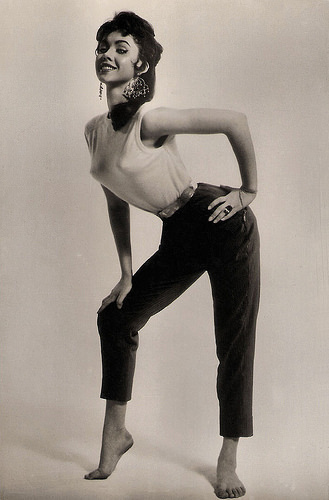
Spanish postcard by Ediciones JRB, no. 201/4. Photo: Mundial Film. Publicity still for The Truth About Women (Muriel Box, 1957).
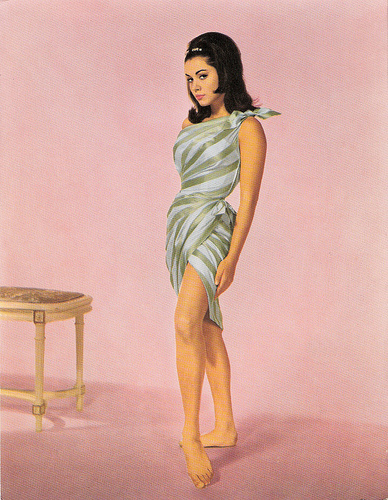
Big German card by ISV, no. PX 4.
Trailer Hell's Belles (1969). Source: Vulture Graffix (YouTube).
Source: (IMDb), Michael Eaude (The Guardian), Wikipedia and.

Italian postcard by B.F.F. Edit., no. 3566. Photo: Warner Bros. Publicity still for Tickle Me (Norman Taurog, 1965).

German by ISV, Sort. 11/6.

German postcard by Fred. W. Sander-Verlag, Minden / Kolibri, no. 2051.
Not above fibbing about her age
Jackie Lane was born as Jocelyn Olga Bolton in Vienna, Austria, in 1937. She is the youngest daughter of a Russian-born pianist mother, Olga Mironova, and an English father, John Bolton, who worked for an American oil firm. She was educated in New Rochelle, New York, in the United States.
At the age of 14, she moved to Britain where she received dance training. Her elder sister, Mara Lane, was a well-known British model and actress in the 1950s. Jocelyn established herself as a popular model in the United Kingdom by the time she was 18, using the pseudonym Jackie Lane.
She appeared on hundreds of magazine covers around the world. H. David Schleicher at IMDb : "Jackie was not above fibbing about her age; in a 1957 photo pictorial by Russ Meyer in Modern Man, the 20-year-old Jackie is referred to as 'Mara's 18-year-old sister'. "
From 1954 on, she acted in several British films like the travel film April in Portugal (Euan Lloyd, 1954/1956). She also appeared in the Anglo-American science fiction film The Gamma People (John Gilling, 1955) starring Paul Douglas, and the Frankie Vaughan musicals These Dangerous Years (Herbert Wilcox, 1957) and Wonderful Things! (Herbert Wilcox, 1958).
She played a supporting part in The Angry Hills (Robert Aldrich, 1959), based on the novel by Leon Uris, and starring Robert Mitchum. She also appeared in the British thriller Jet Storm (Cy Endfield, 1959), with Richard Attenborough, and the Italian adventure film Robin Hood e i pirati/Robin Hood and the Pirates (Giorgio Simonelli, 1960) starring Lex Barker .

German by Kolibri-Verlag G.m.b.H. Minden/Westf., no. 1614.

German postcard by Kolibri-Verlag G.m.b.H., Minden-Westf., no. 1266.

German cigarette card.
Hell's Belle
In the early 1960s Jackie Lane appeared in several European film productions. She had a supporting part in the drama Aimez-vous Brahms?/Goodbye Again (Anatole Litvak, 1961), starring Ingrid Bergman . The screenplay was written by Samuel A. Taylor, based on the novel by Françoise Sagan.
In Britain, she played in Two and Two Make Six (Freddie Francis, 1962), starring George Chakiris , and the comedy Operation Snatch (Robert Day, 1962) starring Terry-Thomas and George Sanders. In Italy she starred in the Peplums Marte, dio della guerra/Venus Against the Son of Hercules (Marcello Baldi, 1962) opposite Roger Browne, and Le sette folgori di Assur/War Gods of Babylon (Silvio Amadio, 1962), with Howard Duff.
In 1964, Lane moved to Hollywood. As she was confused with another actress named Jackie Lane (known for starring in the TV series Doctor Who), she began to be credited with her full first name, Jocelyn Lane. Her resemblance to Brigitte Bardot was widely remarked upon.
In 1965, Jackie Lane co-starred with Elvis Presley in Tickle Me (Norman Taurog, 1965) and was featured in the September 1966 issue of Playboy magazine. Later, she appeared in several other Hollywood films, including the Western Incident at Phantom Hill (Earl Bellamy, 1966) with Robert Fuller and the action film Hell's Belles (Maury Dexter, 1969), as a biker chick.
Her final film was A Bullet for Pretty Boy (Larry Buchana, 1970), starring Fabian Forte as gangster Pretty Boy Floyd. Lane also made guest appearances on American television series. She retired in 1971.
Two years later, she married Prince Alfonso of Hohenlohe-Langenburg, the playboy who turned the Spanish fishing village of Marbella into a glamorous resort. Lane gave birth to her only child, Princess Arriana Theresa Maria of Hohenlohe-Langenburg, in 1975. The divorce with the Prince was settled with $1m.
H. David Schleicher: "However, she remains in the memory, literally becoming a fixture of her cinematic times. One image of her, used on the poster of her film Hell's Belles (1969), features a ground-level shot of the 32-year old-Jocelyn (looking all of 22) in a black leather miniskirt and boots, staring haughtily at the camera, has become an icon of 1960s pop culture."

Spanish postcard by Ediciones JRB, no. 201/4. Photo: Mundial Film. Publicity still for The Truth About Women (Muriel Box, 1957).

Big German card by ISV, no. PX 4.
Trailer Hell's Belles (1969). Source: Vulture Graffix (YouTube).
Source: (IMDb), Michael Eaude (The Guardian), Wikipedia and.
Published on February 21, 2017 22:00
February 20, 2017
André Mattoni
André Mattoni (1900-1985) was an Austrian stage and film actor, performing mainly in the German, Austrian and Italian cinema. He worked with Friedrich Wilhelm Murnau on Tartüff (1925), but his dream role in another classic of the German silent cinema fell through.
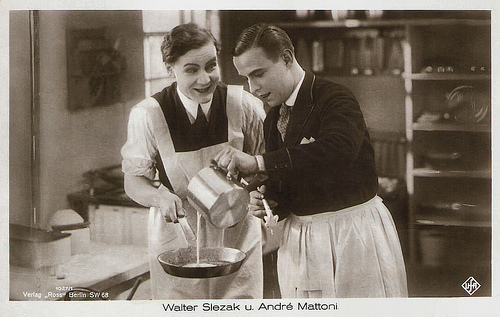
German postcard by Ross Verlag, Berlin, no. 1027/1, 1926-1927. Photo: Ufa. Publicity still for Die gefundene Braut/The Found Bride (1925) with Walter Slezak .
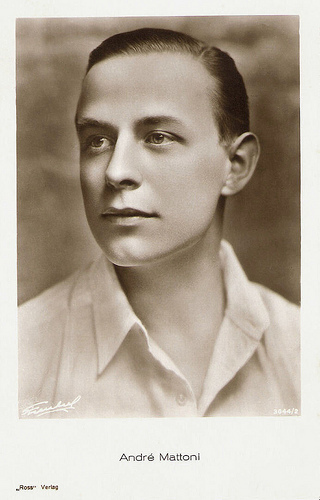
German postcard by Ross Verlag, no. 3064/2, 1928-1929. Photo: Freundlich.
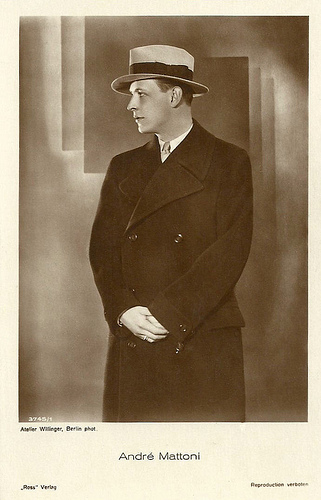
German postcard by Ross Verlag, no. 3745/1, 1928-1929. Photo: Atelier Willinger, Berlin.
Karlsbad mineral water dynasty
André Mattoni was born Andreas Leo Heinrich Edler von Mattoni in Karlsbad, Austria-Hungary (now Karlovy Vary, Czech Republic) in 1900. He stemmed from the Karlsbad mineral water dynasty Mattoni.
Andreas visited the Theresianum in Vienna and had an acting training from the Burgtheater actor Franz Herterich. In the 1922-1923 season he had his stage début at the Burgtheater, the most prestigious theatre of Vienna. Subsequently he acted with the Wiener Kammerspiele, and then toured around Austria.
In 1924 Mattoni went to Berlin to pursue a stage career there. Right away he started to appear in films as well. He played Lysander in the William Shakespeare adaptation Ein Sommernachtstraum/A Midsummer Night's Dream (Hans Neumann, 1925) and soon he had leads in films like Die gefundene Braut/The Found Bride (Rochus Gliese, 1925) opposite Xenia Desni , and Das Fräulein von Amt/Love and Telephone (Hanns Schwarz, 1925).
Then followed a major part in Friedrich Wilhelm Murnau’s masterly modernisation of Molière’s Tartüff/Tartuffe (F.W. Murnau, 1925), as the grandson in the modern section of the film. And then Mattoni was preselected as the protagonist Freder for Fritz Lang’s masterpiece Metropolis (1927). However after some weeks of shooting, Lang was unsatisfied and the part went to Gustav Fröhlich . ( IMDb indicates that it was Mattoni himself who decided "- for whatever reason - to leave the production for good".)
In 1927 Mattoni stayed in Hollywood for a while, where he played a small part in The Student Prince of Old Heidelberg (Ernst Lubitsch, 1927), starring Ramon Novarro and Norma Shearer.
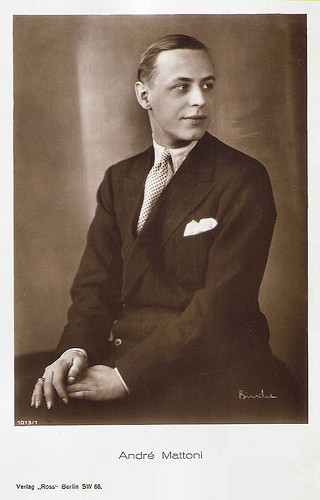
German postcard by Ross Verlag, no. 1013/1, 1927-1928. Photo: Alex Binder.
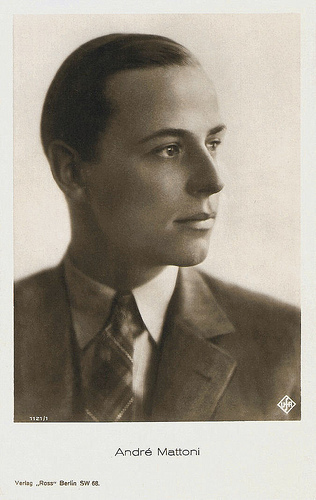
German postcard by Ross Verlag, no. 1121/1, 1927-1928. Photo: Ufa.
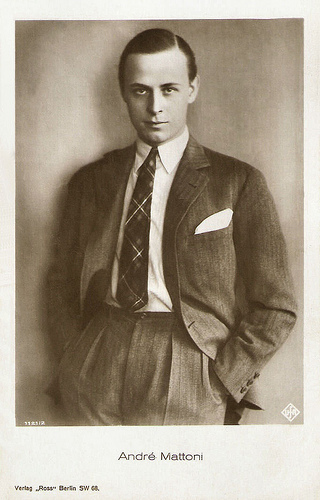
German postcard by Ross Verlag, no. 1121/2, 1927-1928. Photo: Ufa.
Gallant lover
After embodying the gallant lover in some twenty silent German and Austrian films André Mattoni seemed to make the passage from silent to sound cinema relatively easy.
In the course of the early 1930s his film career slowed down though. In 1933 he returned to Austria and performed at the Theater in der Josefstadt. He appeared in the cinema in the operetta Hoheit tanzt Walzer/Majesty Dances Waltzes (Max Neufeld, 1935), shot in Prague, and in the Austrian production Immer wenn ich glucklich bin/Waltz Melodies (Carl Lamac, 1938) with Marta Eggerth .
Then Mattoni followed director Max Neufeld to Italy, and later performed in his Taverna Rossa/Red Tavern (Max Neufeld, 1940), starring Alida Valli . he was billed in Italy as Andrea Mattoni. From 1938 on, he lived in Rome, and worked in Italian films and in German films shot in Roman film studios (often directed by Ernst Marischka).
In 1942 Mattoni returned to Vienna, which became his homestead henceforth. In the postwar era he became production manager for films. He had one last film part in Willi Forst ’s Wiener Mädeln/Viennese Girls (1949).
Between 1957 and 1964 Mattoni was an important collaborator of the Wiener Staatsoper under Herbert von Karajan. In 1978 he performed as the older Lord in the opera Der junge Lord.
André Mattoni died in Vienna in 1985. He was 84.
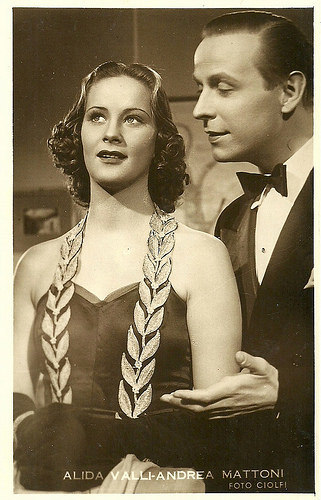
Romanian postcard. Photo: Ciolfi. Publicity still for Taverna Rossa/Red Tavern (Max Neufeld, 1940) with Alida Valli .
Comple version of Tartuffe (1925). Photo: iconauta (YouTube).
Sources: Thomas Staedeli (Cyranos), Wikipedia (German), and .

German postcard by Ross Verlag, Berlin, no. 1027/1, 1926-1927. Photo: Ufa. Publicity still for Die gefundene Braut/The Found Bride (1925) with Walter Slezak .

German postcard by Ross Verlag, no. 3064/2, 1928-1929. Photo: Freundlich.

German postcard by Ross Verlag, no. 3745/1, 1928-1929. Photo: Atelier Willinger, Berlin.
Karlsbad mineral water dynasty
André Mattoni was born Andreas Leo Heinrich Edler von Mattoni in Karlsbad, Austria-Hungary (now Karlovy Vary, Czech Republic) in 1900. He stemmed from the Karlsbad mineral water dynasty Mattoni.
Andreas visited the Theresianum in Vienna and had an acting training from the Burgtheater actor Franz Herterich. In the 1922-1923 season he had his stage début at the Burgtheater, the most prestigious theatre of Vienna. Subsequently he acted with the Wiener Kammerspiele, and then toured around Austria.
In 1924 Mattoni went to Berlin to pursue a stage career there. Right away he started to appear in films as well. He played Lysander in the William Shakespeare adaptation Ein Sommernachtstraum/A Midsummer Night's Dream (Hans Neumann, 1925) and soon he had leads in films like Die gefundene Braut/The Found Bride (Rochus Gliese, 1925) opposite Xenia Desni , and Das Fräulein von Amt/Love and Telephone (Hanns Schwarz, 1925).
Then followed a major part in Friedrich Wilhelm Murnau’s masterly modernisation of Molière’s Tartüff/Tartuffe (F.W. Murnau, 1925), as the grandson in the modern section of the film. And then Mattoni was preselected as the protagonist Freder for Fritz Lang’s masterpiece Metropolis (1927). However after some weeks of shooting, Lang was unsatisfied and the part went to Gustav Fröhlich . ( IMDb indicates that it was Mattoni himself who decided "- for whatever reason - to leave the production for good".)
In 1927 Mattoni stayed in Hollywood for a while, where he played a small part in The Student Prince of Old Heidelberg (Ernst Lubitsch, 1927), starring Ramon Novarro and Norma Shearer.

German postcard by Ross Verlag, no. 1013/1, 1927-1928. Photo: Alex Binder.

German postcard by Ross Verlag, no. 1121/1, 1927-1928. Photo: Ufa.

German postcard by Ross Verlag, no. 1121/2, 1927-1928. Photo: Ufa.
Gallant lover
After embodying the gallant lover in some twenty silent German and Austrian films André Mattoni seemed to make the passage from silent to sound cinema relatively easy.
In the course of the early 1930s his film career slowed down though. In 1933 he returned to Austria and performed at the Theater in der Josefstadt. He appeared in the cinema in the operetta Hoheit tanzt Walzer/Majesty Dances Waltzes (Max Neufeld, 1935), shot in Prague, and in the Austrian production Immer wenn ich glucklich bin/Waltz Melodies (Carl Lamac, 1938) with Marta Eggerth .
Then Mattoni followed director Max Neufeld to Italy, and later performed in his Taverna Rossa/Red Tavern (Max Neufeld, 1940), starring Alida Valli . he was billed in Italy as Andrea Mattoni. From 1938 on, he lived in Rome, and worked in Italian films and in German films shot in Roman film studios (often directed by Ernst Marischka).
In 1942 Mattoni returned to Vienna, which became his homestead henceforth. In the postwar era he became production manager for films. He had one last film part in Willi Forst ’s Wiener Mädeln/Viennese Girls (1949).
Between 1957 and 1964 Mattoni was an important collaborator of the Wiener Staatsoper under Herbert von Karajan. In 1978 he performed as the older Lord in the opera Der junge Lord.
André Mattoni died in Vienna in 1985. He was 84.

Romanian postcard. Photo: Ciolfi. Publicity still for Taverna Rossa/Red Tavern (Max Neufeld, 1940) with Alida Valli .
Comple version of Tartuffe (1925). Photo: iconauta (YouTube).
Sources: Thomas Staedeli (Cyranos), Wikipedia (German), and .
Published on February 20, 2017 22:00
February 19, 2017
Greta Nissen
Norwegian-American Greta Nissen (1906–1988) was a blonde bombshell, who appeared in more than 30 films in Denmark, the United States and England. Unfortunately she is now most famous for a role which was re-shot with another actress.
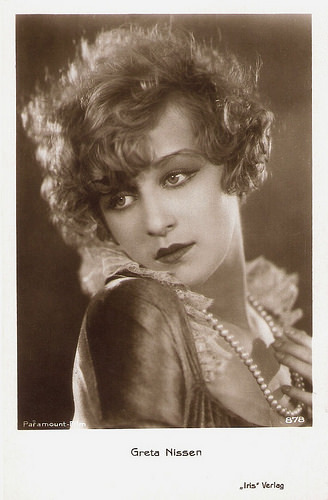
Austrian postcard by Iris Verlag, no. 878. Photo: Paramount-Film.
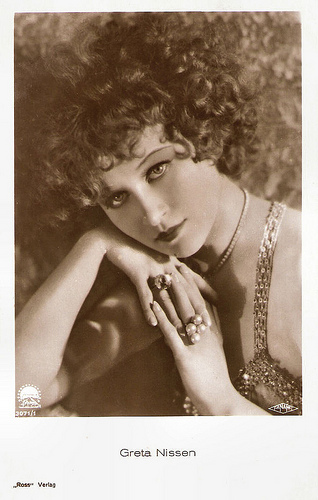
German postcard by Ross Verlag, no. 3071/1, 1928-1929. Photo: Paramount / FaNaMet.
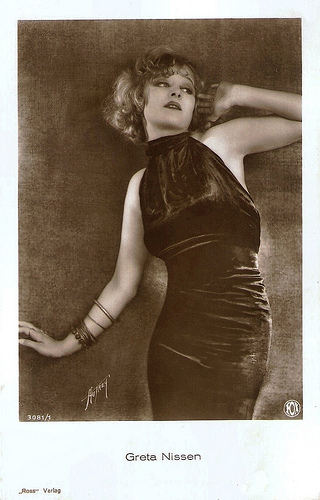
German postcard by Ross Verlag, no. 3081/1, 1928-1929. Photo: Max Munn Autrey / Fox.
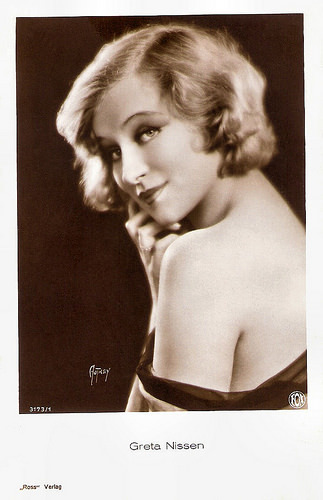
German postcard by Ross Verlag, no. 3173/1, 1928-1929. Photo: Max Munn Autrey / Fox.
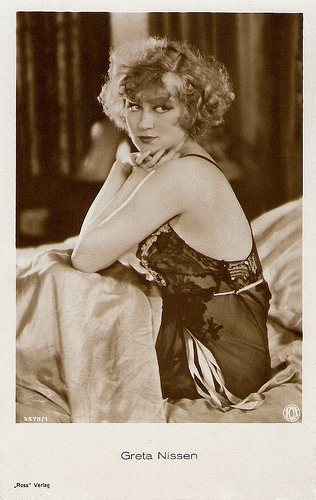
German postcard by Ross Verlag, no. 3575/1, 1928-1929. Photo: Fox.
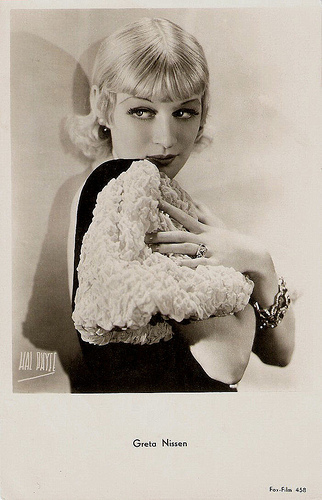
Dutch Postcard, no. 458. Photo: Hal Payfe / Fox Film.
Pat & Patachon
Grethe Rüzt-Nissen was born in Oslo, Norway, in 1906 (some sources say 1905). She was the daughter of Carl Andreas Frantz Nissen and Agnes Magdalene Larsen. After her parents divorced, her mother took her to Copenhagen, Denmark,
In 1911, her mother managed to get Grethe as a student at the Det Kongelige Teater's (Royal Theater) student school, after having 'made' her a year older. Grethe made her stage début as a member of the corps de ballet at the Royal Theater.
Some years later, when the famous choreographer and dancer Mikhail Fokin (or Michel Fokine) came to Denmark after the Russian Revolution, he invited her to come to Paris and she studied with him from 1918 to 1919. In 1922 she performed a series of acclaimed Fokine evenings in Norway.
Grethe made her screen début in the Danish comedies Daarskab, Dyd og Driverter/Folly, Virtue and Idler (Lau Lauritzen, 1924) followed by Lille Lise let-paa-taa/The Little Dancer (Lau Lauritzen, 1924), two vehicles for the comedy team of Fy og Bi (aka Pat & Patachon). These two comedies would be her only films in Scandinavia.
In 1924 she went to New York with a Danish ballet troupe, and there the blonde looker received an offer to appear on Broadway in George S. Kaufman and Marc Connelly's lavish revue Beggar on Horseback. She changed her name to Greta Nissen. Later she worked for the famed Flo Ziegfield in the 1926 production of No Foolin'.
Only 19 years old, she was discovered by Jesse L. Lasky of Paramount Pictures, who signed her to a contract. Making her American screen debut as Greta Nissen in In the Name of Love (Howard Higgin, 1925) with Ricardo Cortez and Wallace Beery, Nissen was singled out by critic Mordaunt Hall of the New York Times, who found her 'an appealing and clever actress with a striking personality'.
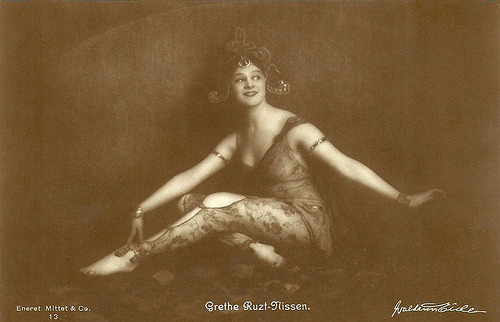
Swedish postcard by Eneret Mittet & Co, no. 13.Collection: Didier Hanson.
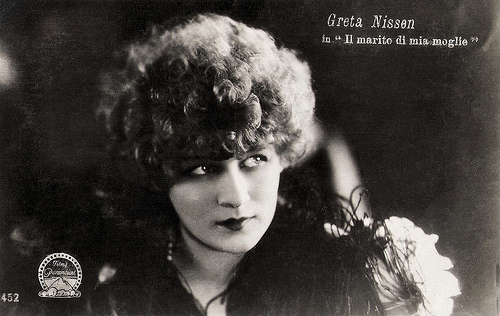
Italian postcard, no. 452. Photo: Films Paramount. Publicity still for Lost: A Wife (William C. de Mille, 1925).
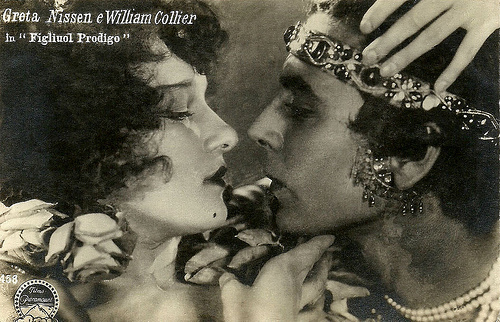
Italian postcard by Casa Editrice Ballerini & Fratini, Firenze (Florence), no. 458. Photo: SAI Filmo Paramount, Roma. Publicity still for The Wanderer (Raoul Walsh, 1925). Collection: Didier Hanson.
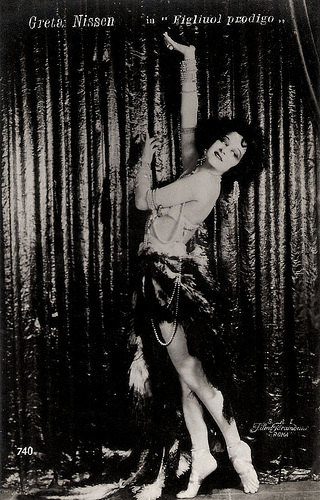
Italian postcard by Casa Editrice Ballerini & Fratini, Firenze (Florence), no. 740. Photo: SAI Filmo Paramount, Roma. Publicity still for The Wanderer (Raoul Walsh, 1925).
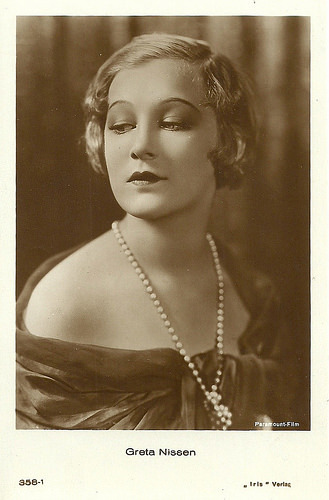
Austrian postcard by Iris Verlag, no. 358/1. Photo: Paramount-Film.
Hell's Angels
Greta Nissen played in several sophisticated comedies with Adolphe Menjou like The Wanderer (Raoul Walsh, 1925) also with William Collier and Blonde or Brunette (Richard Rosson, 1927).
She became an exotic seductress in such costume extravaganzas as The Lady of the Harem (Raoul Walsh, 1926) and Fazil (Howard Hawks, 1928) opposite Charles Farrell.
MGM, meanwhile, borrowed her for The Love Thief (John McDermott, 1926), to replace Greta Garbo . Among her other successful potboilers were Lost: A Wife (William C. de Mille, 1925), The Lucky Lady (Raoul Walsh, 1926) and The Popular Sin (Malcolm St. Clair, 1926).
In 1927 Nissen was the original choice as the leading lady of Hell's Angels (1930), Howard Hughes’ stunt-flying extravaganza set during World War I. This epic film could have made her a major contender.
Filming was well under way when it was decided that the film would be remade with sound. Unfortunately Greta was replaced because of her heavy Norwegian accent. Nissen had made $2500 a week when filming Hell's Angels and her replacement, Jean Harlow, worked for only $250. The film shot Harlow to stardom and Nissen lost much work due to the advent of sound films.
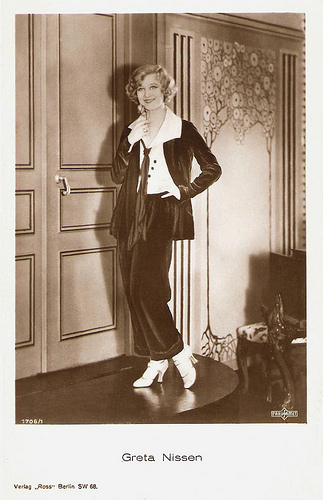
German postcard by Ross Verlag, Berlin, no. 1760/1, 1927-1928. Photo: Parufamet.
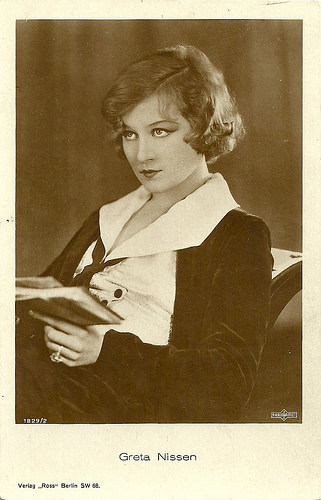
German postcard by Ross Verlag, no. 1829/2, 1927-1928. Photo: Parufamet.
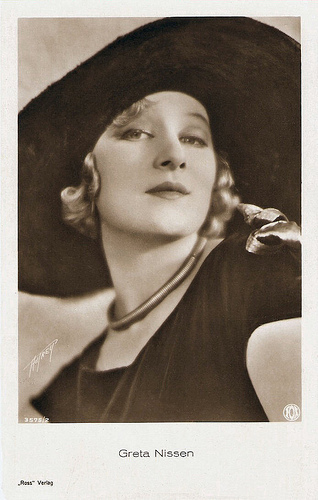
German postcard by Ross Verlag, no. 3575/2, 1928-1929. Photo: Autrey / Fox.
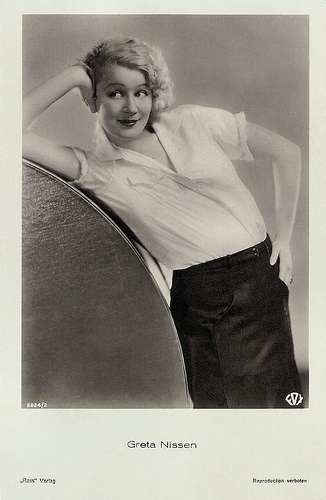
German postcard by Ross Verlag, no. 5824/2, 1930-1931. Photo: Fox.
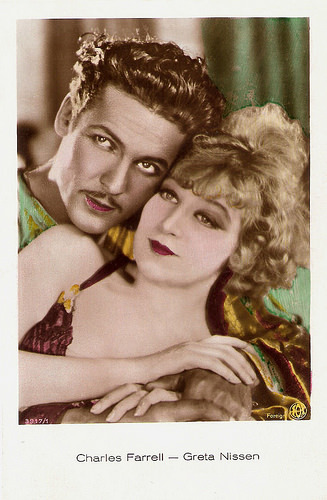
British postcard by Ross Verlag, no. 3917/1, 1928-1929. Photo: Fox. Publicity still for Fazil (Howard Hawks, 1928).
B-films and Quota Quickies
Rebounding somewhat with a contract from Fox, Greta Nissen eventually proved that her accent could easily have been turned into an asset, but the fall-out from the Hell's Angels debacle followed her for the remainder of her film career.
She starred or co-starred in a series of B-films which included the lame Women of All Nations (Raoul Walsh, 1931), the Will Rogers comedy Ambassador Bill (Sam Taylor, 1931), the mystery drama The Circus Queen Murder (Roy William Neill, 1933) again opposite Adolphe Menjou, and the George O'Brien western Life in the Raw (Louis King, 1933).
In 1933 she moved to England where she appeared in a few ‘quota quickies’, including On Secret Service (Arthur B. Woods, 1933) and Honours Easy (Herbert Brenon, 1935) with Margaret Lockwood .
In 1934 she also appeared at the Palace Theatre in London in the original version of Agnes de Mille's ballet Three Virgins and a Devil, performed in the revue Why Not Tonight? After the spy film Cafe Colette (Paul L. Stein, 1937) she retired, and returned to the US.
Divorced from former Fox contract star Weldon Heyburn, Nissen married in 1941 industrialist Stuart Eckert and she lived quietly in California. Greta Nissen died at home in Montecito, California of Parkinson's disease in 1988. She was 82. Her husband said she still received fan letters. Greta had one son, Tor Bruce Nissen Eckert, who in 2005 gave his large collection of Greta Nissen Memorabilia to the Norwegian Emigrant Museum in Ottestad, Norway.
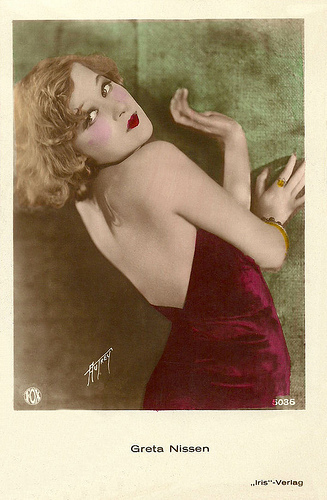
Austrian postcard by Iris Verlag, no. 5035. Photo: Autrey / Fox.
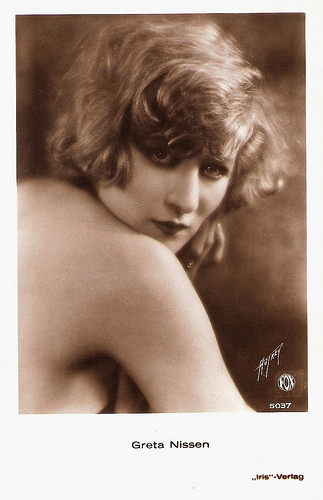
Austrian postcard by Iris-Verlag, no. 5037. Photo: Autrey / Fox.
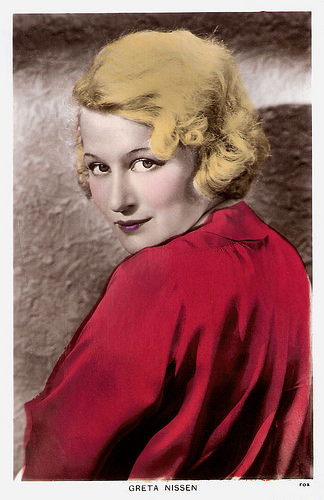
British postcard in the Colourgraph Series, London, no. C 184. Photo: Fox.
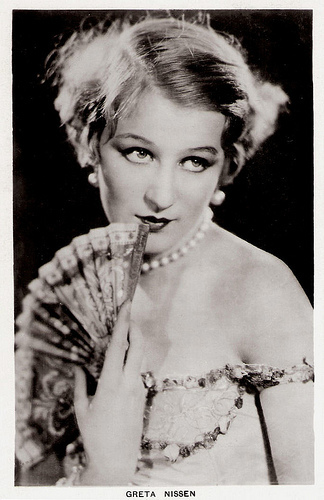
British postcard in the Picturegoer Series, London, no. 264.
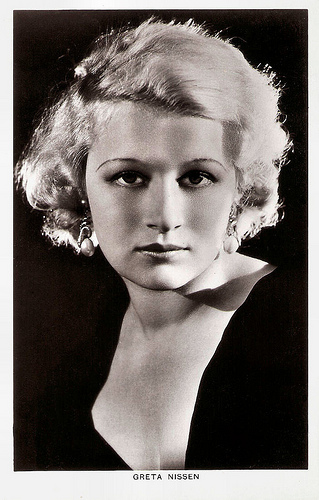
British postcard in the Picturegoer Series, London, no. 264b.
Sources: Hans Otto Christian Arent (Store Norske Lexikon - Norwegian), Hans J. Wollstein (AllMovie), (IMDb), Allure, Pat M. Ryan (Dance Chronicle), Thomas Staedeli (Cyranos), Wikipedia and .

Austrian postcard by Iris Verlag, no. 878. Photo: Paramount-Film.

German postcard by Ross Verlag, no. 3071/1, 1928-1929. Photo: Paramount / FaNaMet.

German postcard by Ross Verlag, no. 3081/1, 1928-1929. Photo: Max Munn Autrey / Fox.

German postcard by Ross Verlag, no. 3173/1, 1928-1929. Photo: Max Munn Autrey / Fox.

German postcard by Ross Verlag, no. 3575/1, 1928-1929. Photo: Fox.

Dutch Postcard, no. 458. Photo: Hal Payfe / Fox Film.
Pat & Patachon
Grethe Rüzt-Nissen was born in Oslo, Norway, in 1906 (some sources say 1905). She was the daughter of Carl Andreas Frantz Nissen and Agnes Magdalene Larsen. After her parents divorced, her mother took her to Copenhagen, Denmark,
In 1911, her mother managed to get Grethe as a student at the Det Kongelige Teater's (Royal Theater) student school, after having 'made' her a year older. Grethe made her stage début as a member of the corps de ballet at the Royal Theater.
Some years later, when the famous choreographer and dancer Mikhail Fokin (or Michel Fokine) came to Denmark after the Russian Revolution, he invited her to come to Paris and she studied with him from 1918 to 1919. In 1922 she performed a series of acclaimed Fokine evenings in Norway.
Grethe made her screen début in the Danish comedies Daarskab, Dyd og Driverter/Folly, Virtue and Idler (Lau Lauritzen, 1924) followed by Lille Lise let-paa-taa/The Little Dancer (Lau Lauritzen, 1924), two vehicles for the comedy team of Fy og Bi (aka Pat & Patachon). These two comedies would be her only films in Scandinavia.
In 1924 she went to New York with a Danish ballet troupe, and there the blonde looker received an offer to appear on Broadway in George S. Kaufman and Marc Connelly's lavish revue Beggar on Horseback. She changed her name to Greta Nissen. Later she worked for the famed Flo Ziegfield in the 1926 production of No Foolin'.
Only 19 years old, she was discovered by Jesse L. Lasky of Paramount Pictures, who signed her to a contract. Making her American screen debut as Greta Nissen in In the Name of Love (Howard Higgin, 1925) with Ricardo Cortez and Wallace Beery, Nissen was singled out by critic Mordaunt Hall of the New York Times, who found her 'an appealing and clever actress with a striking personality'.

Swedish postcard by Eneret Mittet & Co, no. 13.Collection: Didier Hanson.

Italian postcard, no. 452. Photo: Films Paramount. Publicity still for Lost: A Wife (William C. de Mille, 1925).

Italian postcard by Casa Editrice Ballerini & Fratini, Firenze (Florence), no. 458. Photo: SAI Filmo Paramount, Roma. Publicity still for The Wanderer (Raoul Walsh, 1925). Collection: Didier Hanson.

Italian postcard by Casa Editrice Ballerini & Fratini, Firenze (Florence), no. 740. Photo: SAI Filmo Paramount, Roma. Publicity still for The Wanderer (Raoul Walsh, 1925).

Austrian postcard by Iris Verlag, no. 358/1. Photo: Paramount-Film.
Hell's Angels
Greta Nissen played in several sophisticated comedies with Adolphe Menjou like The Wanderer (Raoul Walsh, 1925) also with William Collier and Blonde or Brunette (Richard Rosson, 1927).
She became an exotic seductress in such costume extravaganzas as The Lady of the Harem (Raoul Walsh, 1926) and Fazil (Howard Hawks, 1928) opposite Charles Farrell.
MGM, meanwhile, borrowed her for The Love Thief (John McDermott, 1926), to replace Greta Garbo . Among her other successful potboilers were Lost: A Wife (William C. de Mille, 1925), The Lucky Lady (Raoul Walsh, 1926) and The Popular Sin (Malcolm St. Clair, 1926).
In 1927 Nissen was the original choice as the leading lady of Hell's Angels (1930), Howard Hughes’ stunt-flying extravaganza set during World War I. This epic film could have made her a major contender.
Filming was well under way when it was decided that the film would be remade with sound. Unfortunately Greta was replaced because of her heavy Norwegian accent. Nissen had made $2500 a week when filming Hell's Angels and her replacement, Jean Harlow, worked for only $250. The film shot Harlow to stardom and Nissen lost much work due to the advent of sound films.

German postcard by Ross Verlag, Berlin, no. 1760/1, 1927-1928. Photo: Parufamet.

German postcard by Ross Verlag, no. 1829/2, 1927-1928. Photo: Parufamet.

German postcard by Ross Verlag, no. 3575/2, 1928-1929. Photo: Autrey / Fox.

German postcard by Ross Verlag, no. 5824/2, 1930-1931. Photo: Fox.

British postcard by Ross Verlag, no. 3917/1, 1928-1929. Photo: Fox. Publicity still for Fazil (Howard Hawks, 1928).
B-films and Quota Quickies
Rebounding somewhat with a contract from Fox, Greta Nissen eventually proved that her accent could easily have been turned into an asset, but the fall-out from the Hell's Angels debacle followed her for the remainder of her film career.
She starred or co-starred in a series of B-films which included the lame Women of All Nations (Raoul Walsh, 1931), the Will Rogers comedy Ambassador Bill (Sam Taylor, 1931), the mystery drama The Circus Queen Murder (Roy William Neill, 1933) again opposite Adolphe Menjou, and the George O'Brien western Life in the Raw (Louis King, 1933).
In 1933 she moved to England where she appeared in a few ‘quota quickies’, including On Secret Service (Arthur B. Woods, 1933) and Honours Easy (Herbert Brenon, 1935) with Margaret Lockwood .
In 1934 she also appeared at the Palace Theatre in London in the original version of Agnes de Mille's ballet Three Virgins and a Devil, performed in the revue Why Not Tonight? After the spy film Cafe Colette (Paul L. Stein, 1937) she retired, and returned to the US.
Divorced from former Fox contract star Weldon Heyburn, Nissen married in 1941 industrialist Stuart Eckert and she lived quietly in California. Greta Nissen died at home in Montecito, California of Parkinson's disease in 1988. She was 82. Her husband said she still received fan letters. Greta had one son, Tor Bruce Nissen Eckert, who in 2005 gave his large collection of Greta Nissen Memorabilia to the Norwegian Emigrant Museum in Ottestad, Norway.

Austrian postcard by Iris Verlag, no. 5035. Photo: Autrey / Fox.

Austrian postcard by Iris-Verlag, no. 5037. Photo: Autrey / Fox.

British postcard in the Colourgraph Series, London, no. C 184. Photo: Fox.

British postcard in the Picturegoer Series, London, no. 264.

British postcard in the Picturegoer Series, London, no. 264b.
Sources: Hans Otto Christian Arent (Store Norske Lexikon - Norwegian), Hans J. Wollstein (AllMovie), (IMDb), Allure, Pat M. Ryan (Dance Chronicle), Thomas Staedeli (Cyranos), Wikipedia and .
Published on February 19, 2017 22:00
February 18, 2017
Imported from the USA: Baby Peggy
Diana Serra Cary (1918), best known as Baby Peggy, was one of the three major American child stars of the Hollywood silent movie era along with Jackie Coogan and Baby Marie. However, by the age of 8, her career was finished. She is now the last living star of the silent film era.
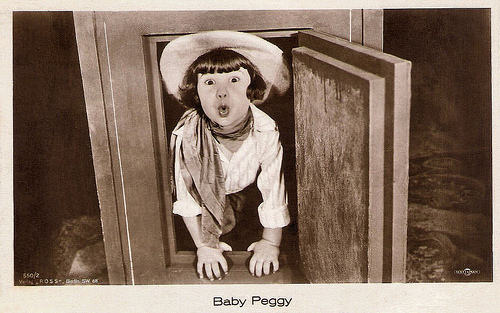
German postcard by Ross Verlag, Berlin, no. 550/2, 1919-1924. Photo: Unifilman.
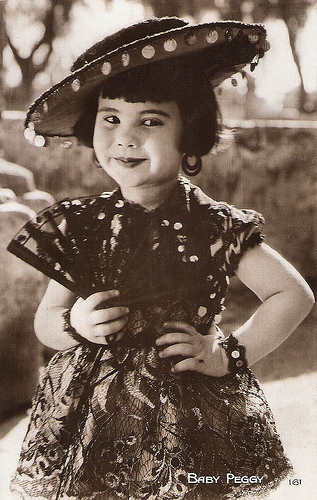
French postcard by Cinémagazine-Edition, Paris, no. 161.
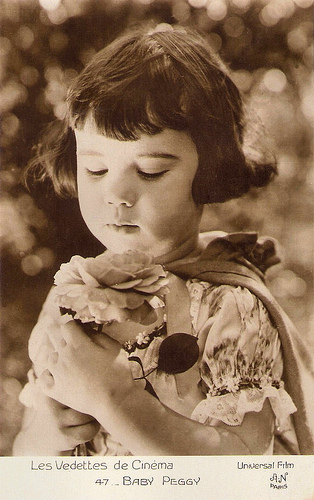
French postcard in Les Vedettes de Cinema series by A.N., Paris, no. 47. Photo: Universal Film.
The Million Dollar Baby
Diana Serra Cary was born in 1918, in San Diego, California, as Peggy-Jean Montgomery, She was the second daughter of Marian (née Baxter) and Jack Montgomery. Her family soon moved to Los Angeles so that her father, Jack, an aspiring cowboy, could find stunt work in Western pictures. He supported himself as Tom Mix's double, but never achieved the rugged stardom he yearned for himself.
Baby Peggy was 'discovered' at the age of 19 months, when she visited Century Studios on Sunset Boulevard in Hollywood with her mother and a film-extra friend. Peggy had an unusually expressive face, matched with a distinctive bob haircut with short bangs.
Impressed by Peggy's well-behaved demeanour and willingness to follow directions from her father, director Fred Fishback (a.k.a. Fred Hibbard) hired her to appear in a series of short films with Century's canine star, the terrier Brownie the Wonder Dog.
The first film, Playmates (Fred Hibbard, 1921), was a success, and Peggy was signed to a long-term contract with Century Studios. Between 1921 and 1923 she made over 150 short comedies for Century. She appeared in film adaptations of novels and fairy tales, such as Hansel and Gretel (Alfred J. Goulding, 1923) and Jack and the Beanstalk (Alfred J. Goulding, 1924), contemporary comedies, and a few full-length films.
Many of Baby Peggy's popular comedies were parodies of films that grown-up stars had made, and she imitated such legends as Rudolph Valentino, Pola Negri, Mary Pickford and Mae Murray. Film historian David Robinson, cited in the Hollywood Reporter : "She wasn't the first child star, (that would be the infant in Louis Lumiere's Repas de bébé/Baby's Dinner (1895)), but she was a naturally gifted comic, a very effective mimic, with a very distinctive personality and a great sense of grown-up mannerisms and affectations."
In 1922, the 4-year-old Baby Peggy received 1.2 million fan letters and by 1924 she had been dubbed 'The Million Dollar Baby' for her $1.5 million a year salary. She was an obsession for millions of Americans who bought Baby Peggy dolls, jewelry, sheet music, even brands of milk.
In 1923, Peggy began working for Universal Studios, appearing in full-length dramatic films. Among her works from this era were The Darling of New York (King Baggot, 1923), and the first screen adaptation of Captain January (Edward F. Cline, 1924). In line with her status as a star, Peggy's Universal films were produced and marketed as Universal Jewels, the studio's most prestigious and most expensive classification. During this time she also played in Helen's Babies (William A. Seiter, 1924) which featured a young Clara Bow.
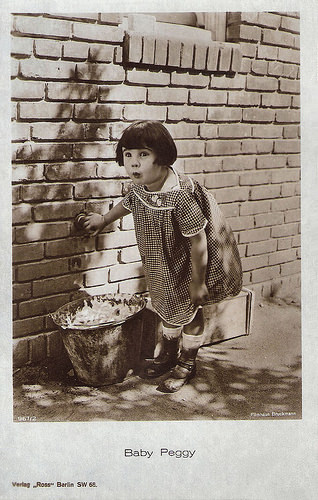
German postcard by Ross Verlag, Berlin no. 967/2 Photo: Filmhaus Bruckmann.
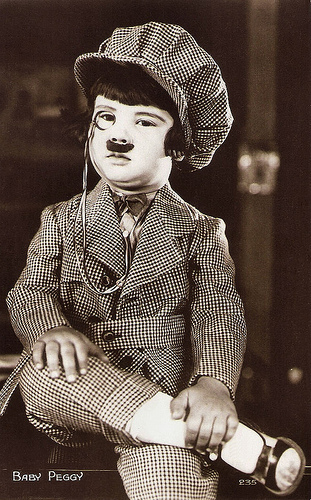
French postcard by Cinémagazine-Edition, Paris, no. 235.
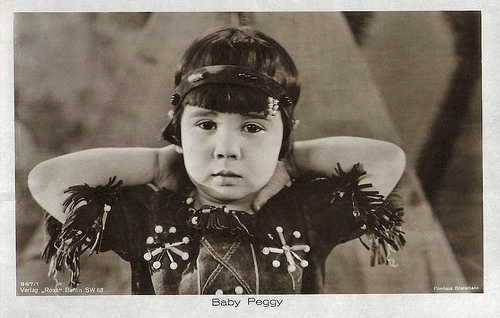
German postcard by Ross Verlag, Berlin no. 967/1, 1925-1926. Photo: Filmhaus Bruckmann.
A Poor Extra
Baby Peggy's film career abruptly ended in 1925 when her father had a falling out with producer Sol Lesser over her salary and cancelled her contract. She found herself essentially blacklisted and was able to land only one more part in silent films, a minor role in the April Fool (Nat Ross, 1926). She was forced to turn to the vaudeville circuit for survival.
Despite her childhood fame and wealth, she found herself poor and working as an extra by the 1930s. Her parents had handled all of the finances; and money was spent on expensive cars, homes, and clothing. Nothing was set aside for the welfare or education of Peggy or her sister. Through reckless spending and corrupt business partners of her father, her entire fortune was gone before she hit puberty.
A Hollywood comeback in the early 1930s as Peggy Montgomery was short-lived. She loathed screen work and retired after appearing as an extra in the Ginger Rodgers comedy Having Wonderful Time (Alfred Santell, 1938). Peggy married bar tender Gordon Ayres whom she met on the set of Ah, Wilderness! (Clarence Brown, 1935). A few years later, she adopted the name Diana Ayres in an effort to distance herself from the Baby Peggy image. The couple divorced in 1948. In 1954, she married graphic artist Robert 'Bob' Cary and they had one son, Mark (1961).
Having an interest in both writing and history since her youth, Peggy found a second career as an author and silent film historian in her later years under the name Diana Serra Cary. She wrote an autobiography of her life as a child star, What Ever Happened to Baby Peggy: The Autobiography of Hollywood's Pioneer Child Star, and a biography of her contemporary and rival, Jackie Coogan: The World's Boy King: A Biography of Hollywood's Legendary Child Star.
Only a handful of Baby Peggy shorts, including Playmates (Fred Hibbard, 1921), Miles of Smiles (Alfred J. Goulding, 1923) and Sweetie (Alfred J. Goulding, 1923) have been discovered and preserved in film archives around the world. Century Studios burned down in 1926. Only the full-length films The Family Secret (William A. Seiter, 1924), Captain January (Edward F. Cline, 1924), Helen's Babies (William A. Seiter, 1924) with Edward Everett Horton, and April Fool (Nat Ross, 1926) have survived. In 2016, it was announced that her lost film Our Pet (Herman C. Raymaker, 1924) was found in Japan by silent film collector Ichiro Kataoka.
Diana Serra Cary herself is one of the few surviving actors of the silent film era. In 2015, she returned to the screen in the short Western Broncho Billy and the Bandit's Secret (David Kiehn, 2015), a tribute to Gilbert M. 'Broncho Billy' Anderson, the first cowboy star, who made Westerns for the Essanay Film Company. Cary played 'the Movie Star'.
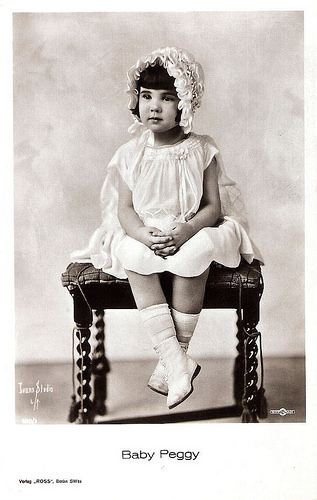
German postcard by Ross Verlag, Berlin no. 560/1, 1919-1924. Photo: Ivans Studio, Los Angeles / Unfilman.
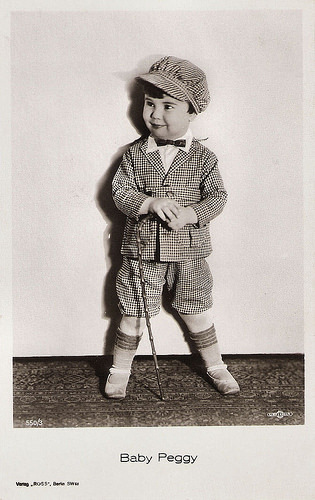
German postcard by Ross Verlag, Berlin no. 550/3, 1919-1924. Photo: Unfilman.
Sources: Chris Gardner (The Hollywood Reporter), (IMDb), Wikipedia and .

German postcard by Ross Verlag, Berlin, no. 550/2, 1919-1924. Photo: Unifilman.

French postcard by Cinémagazine-Edition, Paris, no. 161.

French postcard in Les Vedettes de Cinema series by A.N., Paris, no. 47. Photo: Universal Film.
The Million Dollar Baby
Diana Serra Cary was born in 1918, in San Diego, California, as Peggy-Jean Montgomery, She was the second daughter of Marian (née Baxter) and Jack Montgomery. Her family soon moved to Los Angeles so that her father, Jack, an aspiring cowboy, could find stunt work in Western pictures. He supported himself as Tom Mix's double, but never achieved the rugged stardom he yearned for himself.
Baby Peggy was 'discovered' at the age of 19 months, when she visited Century Studios on Sunset Boulevard in Hollywood with her mother and a film-extra friend. Peggy had an unusually expressive face, matched with a distinctive bob haircut with short bangs.
Impressed by Peggy's well-behaved demeanour and willingness to follow directions from her father, director Fred Fishback (a.k.a. Fred Hibbard) hired her to appear in a series of short films with Century's canine star, the terrier Brownie the Wonder Dog.
The first film, Playmates (Fred Hibbard, 1921), was a success, and Peggy was signed to a long-term contract with Century Studios. Between 1921 and 1923 she made over 150 short comedies for Century. She appeared in film adaptations of novels and fairy tales, such as Hansel and Gretel (Alfred J. Goulding, 1923) and Jack and the Beanstalk (Alfred J. Goulding, 1924), contemporary comedies, and a few full-length films.
Many of Baby Peggy's popular comedies were parodies of films that grown-up stars had made, and she imitated such legends as Rudolph Valentino, Pola Negri, Mary Pickford and Mae Murray. Film historian David Robinson, cited in the Hollywood Reporter : "She wasn't the first child star, (that would be the infant in Louis Lumiere's Repas de bébé/Baby's Dinner (1895)), but she was a naturally gifted comic, a very effective mimic, with a very distinctive personality and a great sense of grown-up mannerisms and affectations."
In 1922, the 4-year-old Baby Peggy received 1.2 million fan letters and by 1924 she had been dubbed 'The Million Dollar Baby' for her $1.5 million a year salary. She was an obsession for millions of Americans who bought Baby Peggy dolls, jewelry, sheet music, even brands of milk.
In 1923, Peggy began working for Universal Studios, appearing in full-length dramatic films. Among her works from this era were The Darling of New York (King Baggot, 1923), and the first screen adaptation of Captain January (Edward F. Cline, 1924). In line with her status as a star, Peggy's Universal films were produced and marketed as Universal Jewels, the studio's most prestigious and most expensive classification. During this time she also played in Helen's Babies (William A. Seiter, 1924) which featured a young Clara Bow.

German postcard by Ross Verlag, Berlin no. 967/2 Photo: Filmhaus Bruckmann.

French postcard by Cinémagazine-Edition, Paris, no. 235.

German postcard by Ross Verlag, Berlin no. 967/1, 1925-1926. Photo: Filmhaus Bruckmann.
A Poor Extra
Baby Peggy's film career abruptly ended in 1925 when her father had a falling out with producer Sol Lesser over her salary and cancelled her contract. She found herself essentially blacklisted and was able to land only one more part in silent films, a minor role in the April Fool (Nat Ross, 1926). She was forced to turn to the vaudeville circuit for survival.
Despite her childhood fame and wealth, she found herself poor and working as an extra by the 1930s. Her parents had handled all of the finances; and money was spent on expensive cars, homes, and clothing. Nothing was set aside for the welfare or education of Peggy or her sister. Through reckless spending and corrupt business partners of her father, her entire fortune was gone before she hit puberty.
A Hollywood comeback in the early 1930s as Peggy Montgomery was short-lived. She loathed screen work and retired after appearing as an extra in the Ginger Rodgers comedy Having Wonderful Time (Alfred Santell, 1938). Peggy married bar tender Gordon Ayres whom she met on the set of Ah, Wilderness! (Clarence Brown, 1935). A few years later, she adopted the name Diana Ayres in an effort to distance herself from the Baby Peggy image. The couple divorced in 1948. In 1954, she married graphic artist Robert 'Bob' Cary and they had one son, Mark (1961).
Having an interest in both writing and history since her youth, Peggy found a second career as an author and silent film historian in her later years under the name Diana Serra Cary. She wrote an autobiography of her life as a child star, What Ever Happened to Baby Peggy: The Autobiography of Hollywood's Pioneer Child Star, and a biography of her contemporary and rival, Jackie Coogan: The World's Boy King: A Biography of Hollywood's Legendary Child Star.
Only a handful of Baby Peggy shorts, including Playmates (Fred Hibbard, 1921), Miles of Smiles (Alfred J. Goulding, 1923) and Sweetie (Alfred J. Goulding, 1923) have been discovered and preserved in film archives around the world. Century Studios burned down in 1926. Only the full-length films The Family Secret (William A. Seiter, 1924), Captain January (Edward F. Cline, 1924), Helen's Babies (William A. Seiter, 1924) with Edward Everett Horton, and April Fool (Nat Ross, 1926) have survived. In 2016, it was announced that her lost film Our Pet (Herman C. Raymaker, 1924) was found in Japan by silent film collector Ichiro Kataoka.
Diana Serra Cary herself is one of the few surviving actors of the silent film era. In 2015, she returned to the screen in the short Western Broncho Billy and the Bandit's Secret (David Kiehn, 2015), a tribute to Gilbert M. 'Broncho Billy' Anderson, the first cowboy star, who made Westerns for the Essanay Film Company. Cary played 'the Movie Star'.

German postcard by Ross Verlag, Berlin no. 560/1, 1919-1924. Photo: Ivans Studio, Los Angeles / Unfilman.

German postcard by Ross Verlag, Berlin no. 550/3, 1919-1924. Photo: Unfilman.
Sources: Chris Gardner (The Hollywood Reporter), (IMDb), Wikipedia and .
Published on February 18, 2017 22:00
February 17, 2017
Alec Guinness
English actor Sir Alec Guinness (1914–2000) was one of the most versatile and subtle actors of his time, in the cinema and on television no less than on the stage. He was master of disguise in several of the classic Ealing Comedies, including Kind Hearts and Coronets in which he played eight different characters. He later won the Academy Award for Best Actor for his role as Colonel Nicholson in The Bridge on the River Kwai, and he is probably even better known for playing Obi-Wan Kenobi in the original Star Wars trilogy.
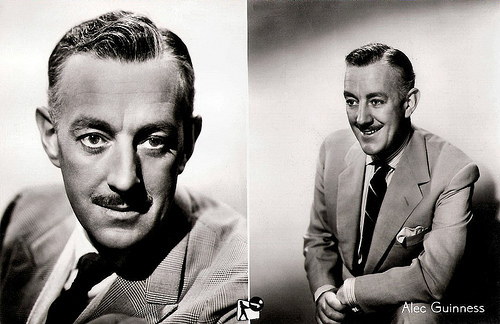
German postcard by Franz Josef Rüdel, Filmpostkartenverlag, Hamburg-Bergedorf, no. D 2367. Photos: J. Arthur Rank-Film. Publicity stills for The Ladykillers (Alexander Mackendrick, 1955).
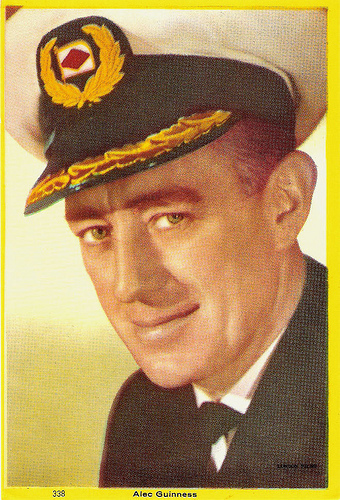
Mexican collector's card, no. 338. Photo: London Films.
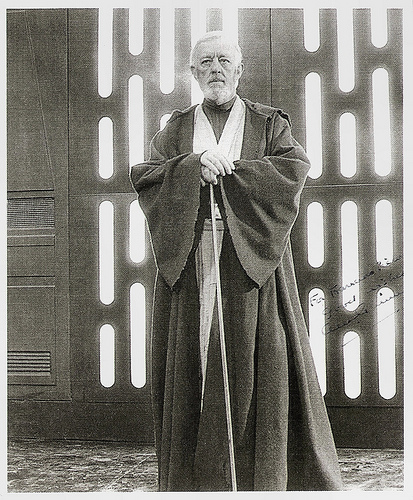
British autograph card. Photo; publicity still for Star Wars (George Lucas, 1977).
Violent, shell-shocked veteran
Alec Guinness was born as Alec Guinness de Cuffe in London in 1914. His mother's maiden name was Agnes Cuff. On Guinness's birth certificate, the space for the mother's name shows Agnes de Cuffe. The space for the infant's name (where first names only are given) says Alec Guinness. The column for name and surname of the father is blank.
It has been frequently speculated that the actor's father was a member of the Irish Guinness family. However, it was an elder Scottish banker, Andrew Geddes, who paid for Guinness's private school education. From 1875, under English law, when the birth of an illegitimate child was registered, the father's name could only be entered on the certificate if he were present and gave his consent.
At five Alec became Alec Stiven, as a consequence of his mother's three-year marriage to Scottish army captain David Stiven, a violent, shell-shocked veteran of the Irish War of Independence. To persuade Alec's mother to submit to his demands, the captain was given to holding a loaded revolver to the boy's head, or hanging him upside down from a bridge.
It was a relief when, at six, Alec was sent away to a prep school, the fees being at least partly paid by Andrew Geddes. At school he directed performances of The Pirates of Penzance and Silas Marner. Later while working as a junior copywriter in an advertising agency, he studied at the Fay Compton Studio of Dramatic Art.
In 1934, he made his stage debut and in 1936, at the age of 22, he played the role of Osric in John Gielgud 's successful production of Hamlet. With the Old Vic he starred in plays by William Shakespeare, George Bernard Shaw, and Anton Chekhov, and worked with actors and actresses who would become his friends and frequent co-stars in the future, including John Gielgud , Peggy Ashcroft, Anthony Quayle, and Jack Hawkins.
In 1938, he starred in a famous modern dress production of Hamlet which won him acclaim on both sides of the Atlantic. He also appeared as Romeo in a production of Romeo and Juliet (1939), as Andrew Aguecheek in Twelfth Night and as Exeter in Henry V in 1937, both opposite Laurence Olivier , and as Ferdinand in The Tempest, opposite Gielgud as Prospero. In 1939, he adapted Charles Dickens' novel Great Expectations for the stage, playing the part of Herbert Pocket. The play was a success.
In World War II, Guinness served in the Royal Navy Volunteer Reserve, first serving as a seaman in 1941 and being commissioned the following year. He commanded a landing craft taking part in the invasion of Sicily and Elba and later ferried supplies to the Yugoslav partisans.
In 1946, he returned to the Old Vic and stayed until 1948, playing Abel Drugger in Ben Jonson's The Alchemist, the Fool in King Lear opposite Laurence Olivier in the title role, DeGuiche in Cyrano de Bergerac opposite Ralph Richardson in the title role, and finally starring in an Old Vic production as Shakespeare's Richard II.
After leaving the Old Vic, he played Eric Birling in J. B. Priestley's An Inspector Calls at the New Theatre in October 1946. He played the Uninvited Guest in the Broadway production of T. S. Eliot's The Cocktail Party (1950, revived at the Edinburgh Festival in 1968). His third attempt at the title role of Hamlet, this time under his own direction at the New Theatre (1951), proved a major theatrical disaster.
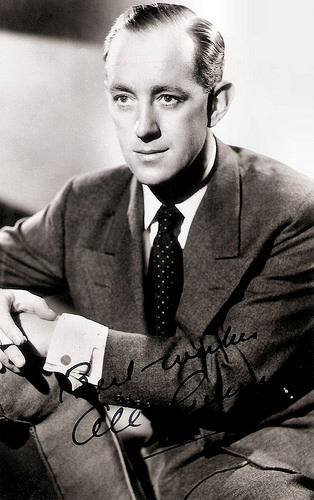
British autograph card.
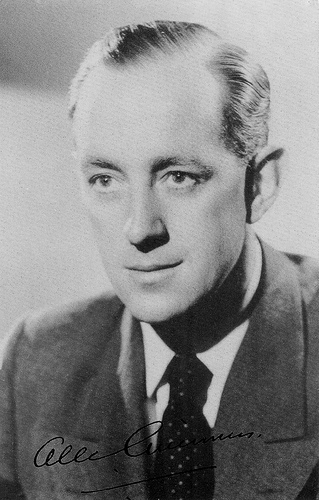
British postcard in the Film Star Autograph Portrait Series by L.D. LTD., London, no. 53.
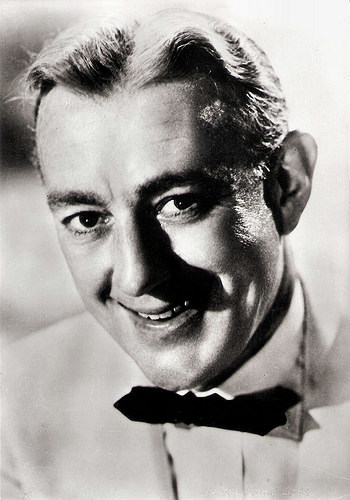
Italian postcard by Alterocca, Terni, no. 49454.
One of the great acting knights of the century
At British Pictures , David Absalom writes: “Alec Guinness was one of the great acting knights of the century. His reputation is sometimes overshadowed by that of the great triumvirate of Olivier, Gielgud and Richardson and it is true that his theatre work is slightly less distinguished than that of the big three, but when it comes to film acting, he far outstrips them.”
Beyond an extra part in Evensong (Victor Saville, 1934) with Evelyn Laye , Guinness’ film career began after World War II with the small but memorable role of Herbert Pocket in Great Expectations (David Lean, 1946) starring John Mills .
Guinness and director David Lean would continue to work on acclaimed films together. Guinness appeared as a repulsive Fagin in Oliver Twist (David Lean, 1948), what was widely criticised for being a Jewish stereotype. Lean later gave him a starring role as the insanely uncompromising Colonel Nicholson opposite William Holden in The Bridge on the River Kwai (David Lean, 1957). For this performance Guinness won an Academy Award.
Despite a difficult and often hostile relationship, Lean, referring to Guinness as ‘my good luck charm’, continued to cast Guinness in character roles in his later films: Arab leader Prince Feisal in Lawrence of Arabia (David Lean, 1962), the title character's half-brother, Bolshevik leader Yevgraf, in Doctor Zhivago (David Lean, 1965), and Indian mystic Godbole in A Passage to India (David Lean, 1984). He was also offered a role in Ryan's Daughter (David Lean, 1970), but declined.
Initially Guinness was associated mainly with the Ealing comedies that made him one of the great character stars of British films. His virtuosity as a master of disguise reached a peak in Kind Hearts and Coronets (Robert Hamer, 1949), when he played all eight members of the D'Ascoyne family whom Dennis Price bumped off on his way to the Dukedom of Chalfont.
Other memorable roles in Ealing classics include the mild and underpaid bank clerk who plots the perfect robbery in The Lavender Hill Mob (Charles Crichton, 1951), an inventor who, to the consternation of management and the unions, invents a fabric that never gets dirty and never wears out in The Man in the White Suit (Alexander Mackendrick, 1951), and the unctuous, snaggle-toothed leader of a gang of incompetent burglars in the last great Ealing Comedy, The Ladykillers (Alexander Mackendrick, 1955).
Director Ronald Neame cast Guinness in his first romantic lead role, opposite Petula Clark in The Card (Ronald Neame, 1952). His conversion to Roman Catholicism followed the shooting of Father Brown (Robert Hamer, 1954) in which he played G.K. Chesterton's cheery parish priest. The film was shot in Burgundy. Between takes Guinness, wandering about the local village in his clerical fig, found himself taken by the hand and subjected to the prattle of a local boy, who imagined he was a genuine priest. The confidence which the Church inspired in the child made a profound impression. Guinness became a Roman Catholic in 1956.
Other notable film roles of this period included the part of the Crown Prince in The Swan (Charles Vidor, 1956) starring Grace Kelly , in her second to last film role, and The Horse's Mouth (Ronald Neame, 1958) in which Guinness played the part of drunken painter Gulley Jimson as well as contributing the screenplay, for which he was nominated for an Academy Award.
He was a vacuum cleaner salesman enlisted into the secret service by Noel Coward in Our Man in Havana (Carol Reed, 1959), Marcus Aurelius in The Fall of the Roman Empire (Anthony Mann, 1964) starring Sophia Loren , Jacob Marley's Ghost in Scrooge (Ronald Neame, 1970) opposite Albert Finney , and Charles I of England in Cromwell (Ken Hughes, 1970) featuring Richard Harris.
He considered the title role in Hitler: The Last Ten Days (Ennio De Concini, 1973) as his best film performance, though critics disagreed. The Telegraph commented in its obituary: “Guinness, having discovered through his usual assiduous research that Hitler was a boring man, unfortunately succeeded brilliantly in bringing this interpretation to the screen.” Guinness won a Tony Award for his Broadway performance as poet Dylan Thomas in Dylan. He next played the title role in Macbeth opposite Simone Signoret at the Royal Court Theatre in 1966, a conspicuous failure.
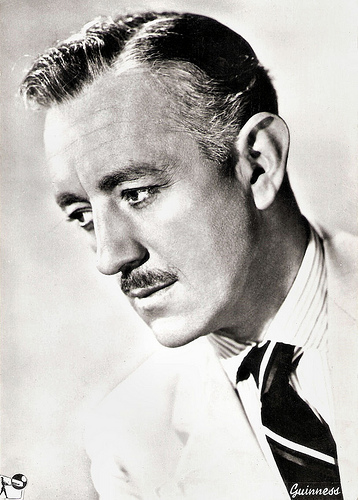
Italian postcard by Bromofoto, Milano (Milan), no. 1291. Photo: Rank. Publicity still for To Paris with Love (Robert Hamer, 1955).
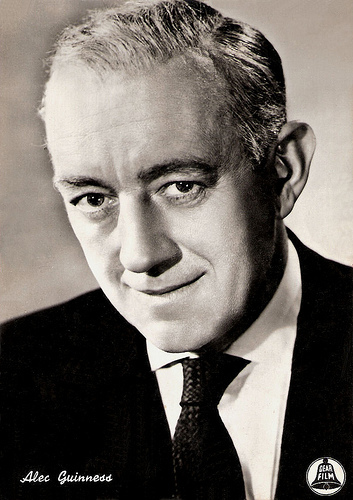
Italian postcard by Bromofoto, Milano (Milan), no. 1500. Photo: Dear Film. Publicity still for The Horse's Mouth (Ronald Neame, 1958).
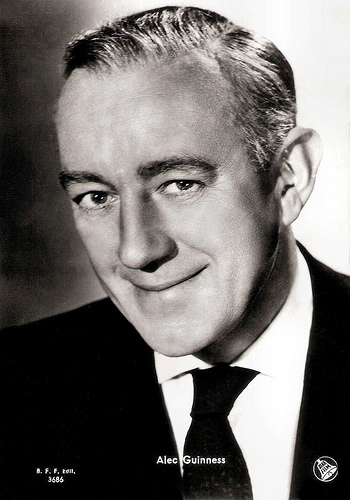
Italian postcard by B.F.F. Edit., no. 3686. Photo: Dear Film. Publicity still for The Horse's Mouth (Ronald Neame, 1958).
Enigmatic Master Spy
From the 1970s, Alec Guinness made regular television appearances. He was perfect as the enigmatic master spy George Smiley in the two television series adapted from John Le Carré's novels, Tinker, Tailor, Soldier, Spy (John Irvin, 1979) and Smiley's People (Simon Langton, 1982). Le Carré was so impressed by Guinness's performance as Smiley that he based his characterisation of Smiley in subsequent novels on Guinness. In the cinema Guinness excelled as Jamessir Bensonmum, the blind butler, in the Neil Simon film Murder By Death (Robert Moore, 1976).
Guinness is now probably best known as Obi-Wan Kenobi in the original Star Wars trilogy, Star Wars: Episode IV - A New Hope (George Lucas, 1977), Star Wars: Episode V - The Empire Strikes Back (Irvin Kershner, 1980), and Star Wars: Episode VI - Return of the Jedi (Richard Marquand, 1983). The part brought him worldwide recognition by a new generation.
Guinness agreed to take the part on the condition that he would not have to do any publicity to promote the film. He was also one of the few cast members who believed that the film would be a box office hit; he negotiated a deal for 2.5 % of the gross, which made him very wealthy in his later life. His role would also result in Golden Globe and Academy Award nominations. Despite these rewards, Guinness soon became unhappy with being identified with the part, and expressed dismay at the fan-following that the Star Wars trilogy attracted.
Guinness received an Academy Honorary Award for lifetime achievement in 1980. In 1988, he got an Academy Award nomination for Best Supporting Actor for Little Dorrit (Christine Edzard, 1988) starring Dereki Jacobi and Joan Greenwood . For his theatre work, he received an Evening Standard Award for his performance as T.E. Lawrence in Ross and a Tony Award for his Broadway turn as Dylan Thomas in Dylan. Guinness was appointed a Commander of the Order of the British Empire (CBE) in 1955, and was knighted in 1959.
Guinness married the artist, playwright, and actress Merula Sylvia Salaman in 1938. In 1940, they had a son, Matthew Guinness, who later became an actor. In his biography, Alec Guinness: The Unknown, Garry O'Connor says that Guinness was arrested and fined 10 guineas for a homosexual act in a public lavatory in Liverpool in 1946. Guinness avoided publicity by giving his name to police and court as 'Herbert Pocket', the name of the character he played in Great Expectations. The incident did not become public knowledge until April 2001, eight months after his death.
Piers Paul Read, Guinness's official biographer, doubts that this incident actually occurred. He believes that Guinness was confused with John Gielgud, who was infamously arrested for such an act around the same period. According to Piers Paul Read, Guinness' friends and family knew of his bisexuality.
Guinness wrote three volumes of a bestselling autobiography, beginning with Blessings in Disguise (1985), followed by My Name Escapes Me (1996), and A Positively Final Appearance (1999). He continued to act almost until his death, submerging himself in an amazing array of characters. His final stage performance was at the Comedy Theatre in 1989 in the play A Walk in the Woods. Between 1934 and 1989, he had played 77 parts in the theatre.
His final film role was a one-scene cameo in the horror thriller Mute Witness (Anthony Waller, 1994) and his last TV role was in the TV-film Eskimo Day (Piers Haggard, 1996).
Alec Guinness died in 2000, from liver cancer, at Midhurst in West Sussex at the age of 86. In his obituary in The Guardian , Tom Sutcliffe calls him ‘a by nature an unostentatious and reserved man’: “Though he undertook a great variety of roles, all were informed, at heart, with the wisdom of the sad clown. It was that spiritual severity, together with those clear, wide-open eyes - capable of melting in close-up on screen into the most reassuringly serene of smiles - which lent his performances force and authenticity.“
Trailer Kind Hearts and Coronets (1949). Source: Film365 (YouTube).
Trailer The Ladykillers (1955). Source: webothlovesoup (YouTube).
Trailer The Bridge on the River Kwai (1957). Source: Sony Pictures Home Entertainment (YouTube).
Trailer Lawrence of Arabia (1962). Source: Cherry Movies (YouTube).
Video trailer Star Wars: Episode IV - A New Hope (1977). Source: Video Detective (YouTube).
Sources: Brian McFarlane (Encyclopedia of British Cinema), Tom Sutcliffe (The Guardian), David Absalom (British Pictures), (IMDb), The Telegraph, BritMovie, Wikipedia, and .

German postcard by Franz Josef Rüdel, Filmpostkartenverlag, Hamburg-Bergedorf, no. D 2367. Photos: J. Arthur Rank-Film. Publicity stills for The Ladykillers (Alexander Mackendrick, 1955).

Mexican collector's card, no. 338. Photo: London Films.

British autograph card. Photo; publicity still for Star Wars (George Lucas, 1977).
Violent, shell-shocked veteran
Alec Guinness was born as Alec Guinness de Cuffe in London in 1914. His mother's maiden name was Agnes Cuff. On Guinness's birth certificate, the space for the mother's name shows Agnes de Cuffe. The space for the infant's name (where first names only are given) says Alec Guinness. The column for name and surname of the father is blank.
It has been frequently speculated that the actor's father was a member of the Irish Guinness family. However, it was an elder Scottish banker, Andrew Geddes, who paid for Guinness's private school education. From 1875, under English law, when the birth of an illegitimate child was registered, the father's name could only be entered on the certificate if he were present and gave his consent.
At five Alec became Alec Stiven, as a consequence of his mother's three-year marriage to Scottish army captain David Stiven, a violent, shell-shocked veteran of the Irish War of Independence. To persuade Alec's mother to submit to his demands, the captain was given to holding a loaded revolver to the boy's head, or hanging him upside down from a bridge.
It was a relief when, at six, Alec was sent away to a prep school, the fees being at least partly paid by Andrew Geddes. At school he directed performances of The Pirates of Penzance and Silas Marner. Later while working as a junior copywriter in an advertising agency, he studied at the Fay Compton Studio of Dramatic Art.
In 1934, he made his stage debut and in 1936, at the age of 22, he played the role of Osric in John Gielgud 's successful production of Hamlet. With the Old Vic he starred in plays by William Shakespeare, George Bernard Shaw, and Anton Chekhov, and worked with actors and actresses who would become his friends and frequent co-stars in the future, including John Gielgud , Peggy Ashcroft, Anthony Quayle, and Jack Hawkins.
In 1938, he starred in a famous modern dress production of Hamlet which won him acclaim on both sides of the Atlantic. He also appeared as Romeo in a production of Romeo and Juliet (1939), as Andrew Aguecheek in Twelfth Night and as Exeter in Henry V in 1937, both opposite Laurence Olivier , and as Ferdinand in The Tempest, opposite Gielgud as Prospero. In 1939, he adapted Charles Dickens' novel Great Expectations for the stage, playing the part of Herbert Pocket. The play was a success.
In World War II, Guinness served in the Royal Navy Volunteer Reserve, first serving as a seaman in 1941 and being commissioned the following year. He commanded a landing craft taking part in the invasion of Sicily and Elba and later ferried supplies to the Yugoslav partisans.
In 1946, he returned to the Old Vic and stayed until 1948, playing Abel Drugger in Ben Jonson's The Alchemist, the Fool in King Lear opposite Laurence Olivier in the title role, DeGuiche in Cyrano de Bergerac opposite Ralph Richardson in the title role, and finally starring in an Old Vic production as Shakespeare's Richard II.
After leaving the Old Vic, he played Eric Birling in J. B. Priestley's An Inspector Calls at the New Theatre in October 1946. He played the Uninvited Guest in the Broadway production of T. S. Eliot's The Cocktail Party (1950, revived at the Edinburgh Festival in 1968). His third attempt at the title role of Hamlet, this time under his own direction at the New Theatre (1951), proved a major theatrical disaster.

British autograph card.

British postcard in the Film Star Autograph Portrait Series by L.D. LTD., London, no. 53.

Italian postcard by Alterocca, Terni, no. 49454.
One of the great acting knights of the century
At British Pictures , David Absalom writes: “Alec Guinness was one of the great acting knights of the century. His reputation is sometimes overshadowed by that of the great triumvirate of Olivier, Gielgud and Richardson and it is true that his theatre work is slightly less distinguished than that of the big three, but when it comes to film acting, he far outstrips them.”
Beyond an extra part in Evensong (Victor Saville, 1934) with Evelyn Laye , Guinness’ film career began after World War II with the small but memorable role of Herbert Pocket in Great Expectations (David Lean, 1946) starring John Mills .
Guinness and director David Lean would continue to work on acclaimed films together. Guinness appeared as a repulsive Fagin in Oliver Twist (David Lean, 1948), what was widely criticised for being a Jewish stereotype. Lean later gave him a starring role as the insanely uncompromising Colonel Nicholson opposite William Holden in The Bridge on the River Kwai (David Lean, 1957). For this performance Guinness won an Academy Award.
Despite a difficult and often hostile relationship, Lean, referring to Guinness as ‘my good luck charm’, continued to cast Guinness in character roles in his later films: Arab leader Prince Feisal in Lawrence of Arabia (David Lean, 1962), the title character's half-brother, Bolshevik leader Yevgraf, in Doctor Zhivago (David Lean, 1965), and Indian mystic Godbole in A Passage to India (David Lean, 1984). He was also offered a role in Ryan's Daughter (David Lean, 1970), but declined.
Initially Guinness was associated mainly with the Ealing comedies that made him one of the great character stars of British films. His virtuosity as a master of disguise reached a peak in Kind Hearts and Coronets (Robert Hamer, 1949), when he played all eight members of the D'Ascoyne family whom Dennis Price bumped off on his way to the Dukedom of Chalfont.
Other memorable roles in Ealing classics include the mild and underpaid bank clerk who plots the perfect robbery in The Lavender Hill Mob (Charles Crichton, 1951), an inventor who, to the consternation of management and the unions, invents a fabric that never gets dirty and never wears out in The Man in the White Suit (Alexander Mackendrick, 1951), and the unctuous, snaggle-toothed leader of a gang of incompetent burglars in the last great Ealing Comedy, The Ladykillers (Alexander Mackendrick, 1955).
Director Ronald Neame cast Guinness in his first romantic lead role, opposite Petula Clark in The Card (Ronald Neame, 1952). His conversion to Roman Catholicism followed the shooting of Father Brown (Robert Hamer, 1954) in which he played G.K. Chesterton's cheery parish priest. The film was shot in Burgundy. Between takes Guinness, wandering about the local village in his clerical fig, found himself taken by the hand and subjected to the prattle of a local boy, who imagined he was a genuine priest. The confidence which the Church inspired in the child made a profound impression. Guinness became a Roman Catholic in 1956.
Other notable film roles of this period included the part of the Crown Prince in The Swan (Charles Vidor, 1956) starring Grace Kelly , in her second to last film role, and The Horse's Mouth (Ronald Neame, 1958) in which Guinness played the part of drunken painter Gulley Jimson as well as contributing the screenplay, for which he was nominated for an Academy Award.
He was a vacuum cleaner salesman enlisted into the secret service by Noel Coward in Our Man in Havana (Carol Reed, 1959), Marcus Aurelius in The Fall of the Roman Empire (Anthony Mann, 1964) starring Sophia Loren , Jacob Marley's Ghost in Scrooge (Ronald Neame, 1970) opposite Albert Finney , and Charles I of England in Cromwell (Ken Hughes, 1970) featuring Richard Harris.
He considered the title role in Hitler: The Last Ten Days (Ennio De Concini, 1973) as his best film performance, though critics disagreed. The Telegraph commented in its obituary: “Guinness, having discovered through his usual assiduous research that Hitler was a boring man, unfortunately succeeded brilliantly in bringing this interpretation to the screen.” Guinness won a Tony Award for his Broadway performance as poet Dylan Thomas in Dylan. He next played the title role in Macbeth opposite Simone Signoret at the Royal Court Theatre in 1966, a conspicuous failure.

Italian postcard by Bromofoto, Milano (Milan), no. 1291. Photo: Rank. Publicity still for To Paris with Love (Robert Hamer, 1955).

Italian postcard by Bromofoto, Milano (Milan), no. 1500. Photo: Dear Film. Publicity still for The Horse's Mouth (Ronald Neame, 1958).

Italian postcard by B.F.F. Edit., no. 3686. Photo: Dear Film. Publicity still for The Horse's Mouth (Ronald Neame, 1958).
Enigmatic Master Spy
From the 1970s, Alec Guinness made regular television appearances. He was perfect as the enigmatic master spy George Smiley in the two television series adapted from John Le Carré's novels, Tinker, Tailor, Soldier, Spy (John Irvin, 1979) and Smiley's People (Simon Langton, 1982). Le Carré was so impressed by Guinness's performance as Smiley that he based his characterisation of Smiley in subsequent novels on Guinness. In the cinema Guinness excelled as Jamessir Bensonmum, the blind butler, in the Neil Simon film Murder By Death (Robert Moore, 1976).
Guinness is now probably best known as Obi-Wan Kenobi in the original Star Wars trilogy, Star Wars: Episode IV - A New Hope (George Lucas, 1977), Star Wars: Episode V - The Empire Strikes Back (Irvin Kershner, 1980), and Star Wars: Episode VI - Return of the Jedi (Richard Marquand, 1983). The part brought him worldwide recognition by a new generation.
Guinness agreed to take the part on the condition that he would not have to do any publicity to promote the film. He was also one of the few cast members who believed that the film would be a box office hit; he negotiated a deal for 2.5 % of the gross, which made him very wealthy in his later life. His role would also result in Golden Globe and Academy Award nominations. Despite these rewards, Guinness soon became unhappy with being identified with the part, and expressed dismay at the fan-following that the Star Wars trilogy attracted.
Guinness received an Academy Honorary Award for lifetime achievement in 1980. In 1988, he got an Academy Award nomination for Best Supporting Actor for Little Dorrit (Christine Edzard, 1988) starring Dereki Jacobi and Joan Greenwood . For his theatre work, he received an Evening Standard Award for his performance as T.E. Lawrence in Ross and a Tony Award for his Broadway turn as Dylan Thomas in Dylan. Guinness was appointed a Commander of the Order of the British Empire (CBE) in 1955, and was knighted in 1959.
Guinness married the artist, playwright, and actress Merula Sylvia Salaman in 1938. In 1940, they had a son, Matthew Guinness, who later became an actor. In his biography, Alec Guinness: The Unknown, Garry O'Connor says that Guinness was arrested and fined 10 guineas for a homosexual act in a public lavatory in Liverpool in 1946. Guinness avoided publicity by giving his name to police and court as 'Herbert Pocket', the name of the character he played in Great Expectations. The incident did not become public knowledge until April 2001, eight months after his death.
Piers Paul Read, Guinness's official biographer, doubts that this incident actually occurred. He believes that Guinness was confused with John Gielgud, who was infamously arrested for such an act around the same period. According to Piers Paul Read, Guinness' friends and family knew of his bisexuality.
Guinness wrote three volumes of a bestselling autobiography, beginning with Blessings in Disguise (1985), followed by My Name Escapes Me (1996), and A Positively Final Appearance (1999). He continued to act almost until his death, submerging himself in an amazing array of characters. His final stage performance was at the Comedy Theatre in 1989 in the play A Walk in the Woods. Between 1934 and 1989, he had played 77 parts in the theatre.
His final film role was a one-scene cameo in the horror thriller Mute Witness (Anthony Waller, 1994) and his last TV role was in the TV-film Eskimo Day (Piers Haggard, 1996).
Alec Guinness died in 2000, from liver cancer, at Midhurst in West Sussex at the age of 86. In his obituary in The Guardian , Tom Sutcliffe calls him ‘a by nature an unostentatious and reserved man’: “Though he undertook a great variety of roles, all were informed, at heart, with the wisdom of the sad clown. It was that spiritual severity, together with those clear, wide-open eyes - capable of melting in close-up on screen into the most reassuringly serene of smiles - which lent his performances force and authenticity.“
Trailer Kind Hearts and Coronets (1949). Source: Film365 (YouTube).
Trailer The Ladykillers (1955). Source: webothlovesoup (YouTube).
Trailer The Bridge on the River Kwai (1957). Source: Sony Pictures Home Entertainment (YouTube).
Trailer Lawrence of Arabia (1962). Source: Cherry Movies (YouTube).
Video trailer Star Wars: Episode IV - A New Hope (1977). Source: Video Detective (YouTube).
Sources: Brian McFarlane (Encyclopedia of British Cinema), Tom Sutcliffe (The Guardian), David Absalom (British Pictures), (IMDb), The Telegraph, BritMovie, Wikipedia, and .
Published on February 17, 2017 22:00
February 16, 2017
Arletty
Blessed with a combination of charisma, good looks and impressive acting ability, Arletty (1898-1992) portrayed several femme fatales, vamps, prostitutes in French films and stage plays of the 1930s and 1940s. Her characters were down-to-earth, earthy, slightly comical female types, usually complex characters with a tough outer shell which concealed an inner vulnerability. She was unforgettable as the ethereal and mysterious Garance in the classic Les Enfants du Paradis/Children of Paradise (Marcel Carné, 1945). When the Second World War ended, Arletty's career was marked with controversy. During the occupation of France she had fallen in love with a German officer, and after the liberation she was jailed as a collaborator. Her career would continue after a suspension but never reached the same level as before and during the war.
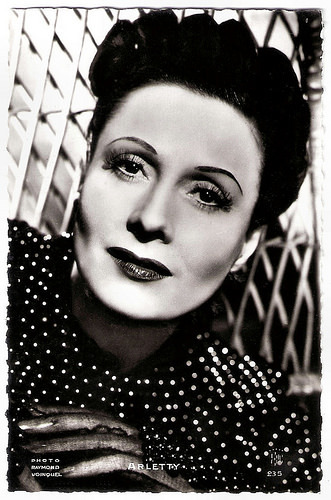
French postcard by EPC, no. 235. Photo: Raymond Voinquel.

French postcard by S.E.R.P., Paris, no. 88. Photo: Studio Harcourt.

French postcard by Editions P.I., no. 67. Offered by S.A. Victoria, Brussels, no. 639. Photo: Ch. van Damme / Les Mirages.

French postcard by SERP, Paris, no. 89. Photo: Studio Harcourt.
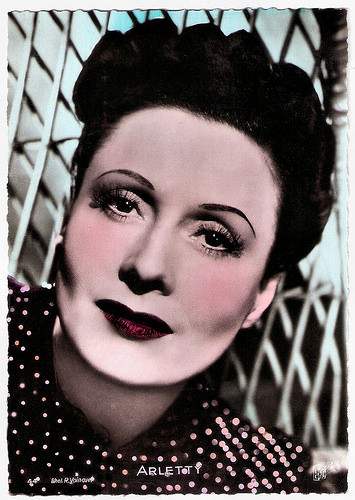
French postcard by Editions et Publications Cinematographiques (EPC), no. 44. Photo: Raymond Voinquel.
A Seductive Siren
Arletty was born Léonie Marie Julie Bathiat in Courbevoie near Paris in 1898, to a working-class family. Her father was a streetcar driver, and her mother a linen maid.
In 1914 on the third day of First World War, she lost her lover, a boy whose eyes were so blue that everybody called him Ciel (Sky). She then swore she would never marry nor have children, so she could never become a war widow or the mother of a dead soldier. She would hold word despite affairs with Sacha Guitry and Aga Khan.
Arletty worked for a time in a factory and as a secretary before becoming a model for painters and photographers. In 1918 she started her stage career as a chorus girl in the music hall. In 1920 she joined the Théâtre des Capucines and appeared there in innumerable revues. At other Parisian theatres she also appeared in such operettas as Oui (Yes, 1928) and comedies such as Les Joies du Capitole (The Enjoyments of the Capitol, 1936) and Fric-Frac (Burglars, 1936).
Arletty was already a stage performer for ten years before she made her film début in La douceur d'aimer/The sweetness of loving (René Hervil, 1930). The arrival of sound cinema coincided with Arletty’s move into films. The following years she appeared in such comedies as Enlevez-moi (Léonce Perret, 1932) with Roger Tréville , Mademoiselle Josette, ma femme/Miss Josette, My Wife (André Berthomieu, 1933) starring Annabella , and Amants et voleurs/Lovers and Thieves (Raymond Bernard, 1935) opposite Michel Simon .
These early film appearances established her as the strong yet marginalised female character with which she would be most identified in later years. In 1935, Arletty was directed by Jacques Feyder in the film Pension Mimosas. She dazzled film audiences in Marcel Carné and Jacques Prevert's classics of French poetic realism, Hôtel du Nord/Hotel of the North (Marcel Carné, 1938) starring Annabella , Le Jour se lève/Daybreak (Marcel Carné, 1939) with Jean Gabin , and Les Visiteurs du soir/The Devil's Envoys (Marcel Carné, 1942) with Alain Cuny .
She played a marvelous leading lady full of cheeky humor and charm again opposite Michel Simon in the film comedies Fric-frac/Burglars (Claude Autant-Lara, Maurice Lehmann, 1939) and Circonstances atténuantes/Extenuating Circumstances (Jean Boyer, 1939). Arletty rarely received top billing although she outshone the lead actors in most of her films.
The anonymous biographer at Films de France writes: “In her films, Arletty was rarely the heroine, the kind of character to win the audience’s sympathy. Rather, she was usually the seductive siren, who would win a man’s heart and then abandon him. Arletty was arguably the first and the best, of the film femme fatales, a perfect subject for the poetic realists of the late 1930s.”
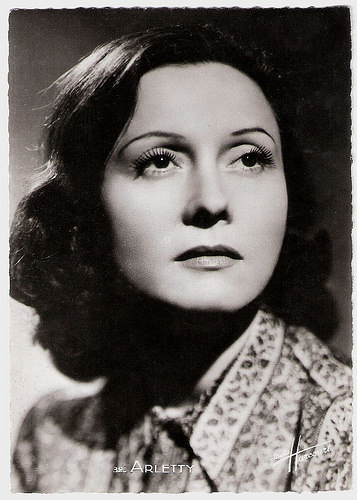
French postcard by Greff Editeur, Paris, no. 32. Photo: Studio Harcourt.
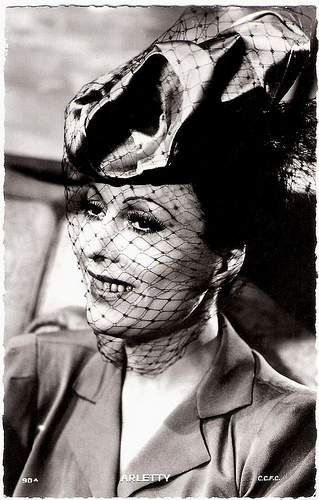
French postcard by Edit. Chantal, Rueil, no. 90A. Photo: C.C.F.C.

French postcard by Editions E.C., Paris, no. 90. Photo: Pathé.

French postcard by Editions P.I., Paris, no. 67.
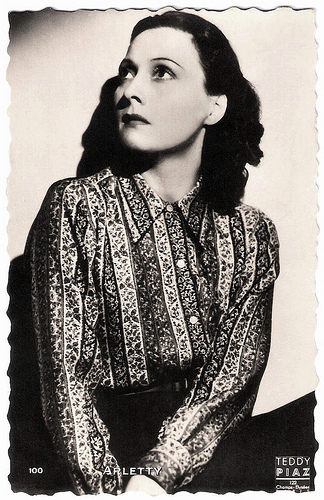
French postcard by Editions O.P., Paris, no. 100. Photo: Teddy Piaz.
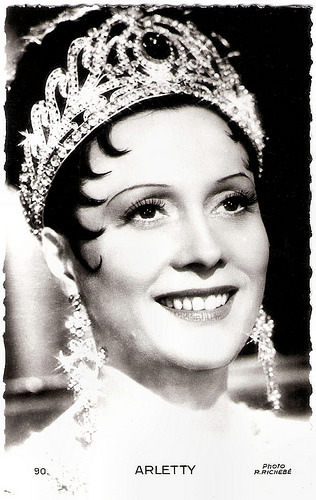
French postcard by Edit. Chantal, Rueil, no. 90. Photo: Roger Richebé. Publicity still for Madame Sans-Gêne (Roger Richebé, 1941).
Horizontal Collaboration
Arletty’s fourth and best role for Marcel Carné, the central part of Garance in Les Enfants du Paradis/Children of Paradise (Marcel Carné, 1945) would become her most famous film role. Hal Erickson at AllMovie : “Even in 1945, Marcel Carné's Children of Paradise was regarded as an old-fashioned film. Set in the Parisian theatrical world of the 1840s, Jacques Prévert's screenplay concerns four men in love with the mysterious Garance (Arletty). Each loves Garance in his own fashion, but only the intentions of sensitive mime-actor Deburau ( Jean-Louis Barrault ) are entirely honorable; as a result, it is he who suffers most, hurdling one obstacle after another in pursuit of an evidently unattainable goal.
In the stylised fashion of 19th-century French drama, many grand passions are spent during the film's totally absorbing 195 minutes. Amazingly, the film was produced over a two-year period in virtual secrecy, without the knowledge of the Nazis then occupying France, who would surely have arrested several of the cast and production staff members (including Prévert) for their activities in the Resistance. Children of Paradise has gone on to become one of the great romantic classics of international cinema.”
After the Liberation, Arletty’s career suffered a severe drawback owing to a liaison with a German Officer during the Occupation. For liberated France, she became the symbol of treason or what was called ‘horizontal collaboration’, and for that she had to pay. The price proved to be very high. She was arrested and sent to Drancy concentration camp then to Fresnes prison (near Paris) where she spent 120 days. In December 1944, she was put under house arrest for another two years and condemned to three years work suspension.
She was not invited to the premiere of Les Enfants du Paradis in March 1945. She allegedly later commented on the experience, "My heart is French but my ass is international." After the suspension she appeared in Carné’s La fleur de l'âge/The Flower of Youth (Marcel Carné, 1947) starring the young Anouk Aimée . In pre-war France, children were jailed under horrific conditions. The film tells of the massive escape that took place on the island of Belle-Ile-en-Mer, and of the child hunt that ensued. The shooting of the film started several times, and was halted for censorship reasons - the project was banned by the Ministry of Justice - and harsh shooting conditions, and finally abandoned. All material of La fleur de l'âge was inexplicably lost in the 1950s.
Arletty next appeared in such film as Portrait d'un assassin/Portrait of a Murderer (Bernard-Roland, 1949) with Maria Montez and Erich von Stroheim , Huis clos/No Exit (Jacqueline Audry, 1954) based on the play by Jean-Paul Sartre, and L'air de Paris (Marcel Carné, 1954) opposite Jean Gabin .
However the cinema did not offer her the grand roles of the pre-war years any more. She returned to the theatre and enjoyed a moderately successful period as a stage actor in later life, notably as Blanche in A Streetcar Named Desire. Among her final screen appearances were a fleeting cameo as an elderly French woman in the international war epic The Longest Day (Ken Annakin, Andrew Marton, Bernhard Wicki, 1962) and a small part in the comedy-drama Le voyage à Biarritz/The Trip to Biarritz (Gilles Grangier, 1963) starring Fernandel .
In 1963, an accident left her nearly blind, and forced her to retire. She eventually returned to the stage, notably in the leading role in Jean Cocteau’s Les Monstres sacrés (The Holy Monsters, 1966), and to film as a madam in Jean-Claude Brialy ’s Les Volets fermés/The Closed Shutters (Jean-Claude Brialy, 1972). In 1971 she published an autobiography, La Défense.
Arletty died in 1992. The funeral cortege made a stop in front of the Hotel du Nord in Paris where her famous film of 1938 is located. Christopher Gresecque at IMDb : “She always illuminated the screen with an unusual mixture of Parisian working-class sense of humor and her romantic beauty.”
Scene from Hôtel Du Nord (1938). Source: Disney Romain (YouTube).
75th Anniversary Trailer for Le Jour se lève/Daybreak (1939). Source: Studiocanal UK (YouTube).
Original trailer for Les Enfants du Paradis (1945). Source: neondreams 25 (YouTube).
U.S. Re-Release Trailer for Les Enfants du Paradis/Children of Paradise (1945). Source: Janus Films (YouTube).
French trailer for the TV film Arletty, une passion coupable/Arletty, a guilty passion (Arnaud Sélignac, 2015) with Laetitia Casta as Arletty. Source: Flach Film Production (YouTube).
Sources: Hal Erickson (AllMovie), (IMDb), Films de France, Encyclopaedia Brittanica, AlloCiné (French), Wikipedia and .

French postcard by EPC, no. 235. Photo: Raymond Voinquel.

French postcard by S.E.R.P., Paris, no. 88. Photo: Studio Harcourt.

French postcard by Editions P.I., no. 67. Offered by S.A. Victoria, Brussels, no. 639. Photo: Ch. van Damme / Les Mirages.

French postcard by SERP, Paris, no. 89. Photo: Studio Harcourt.

French postcard by Editions et Publications Cinematographiques (EPC), no. 44. Photo: Raymond Voinquel.
A Seductive Siren
Arletty was born Léonie Marie Julie Bathiat in Courbevoie near Paris in 1898, to a working-class family. Her father was a streetcar driver, and her mother a linen maid.
In 1914 on the third day of First World War, she lost her lover, a boy whose eyes were so blue that everybody called him Ciel (Sky). She then swore she would never marry nor have children, so she could never become a war widow or the mother of a dead soldier. She would hold word despite affairs with Sacha Guitry and Aga Khan.
Arletty worked for a time in a factory and as a secretary before becoming a model for painters and photographers. In 1918 she started her stage career as a chorus girl in the music hall. In 1920 she joined the Théâtre des Capucines and appeared there in innumerable revues. At other Parisian theatres she also appeared in such operettas as Oui (Yes, 1928) and comedies such as Les Joies du Capitole (The Enjoyments of the Capitol, 1936) and Fric-Frac (Burglars, 1936).
Arletty was already a stage performer for ten years before she made her film début in La douceur d'aimer/The sweetness of loving (René Hervil, 1930). The arrival of sound cinema coincided with Arletty’s move into films. The following years she appeared in such comedies as Enlevez-moi (Léonce Perret, 1932) with Roger Tréville , Mademoiselle Josette, ma femme/Miss Josette, My Wife (André Berthomieu, 1933) starring Annabella , and Amants et voleurs/Lovers and Thieves (Raymond Bernard, 1935) opposite Michel Simon .
These early film appearances established her as the strong yet marginalised female character with which she would be most identified in later years. In 1935, Arletty was directed by Jacques Feyder in the film Pension Mimosas. She dazzled film audiences in Marcel Carné and Jacques Prevert's classics of French poetic realism, Hôtel du Nord/Hotel of the North (Marcel Carné, 1938) starring Annabella , Le Jour se lève/Daybreak (Marcel Carné, 1939) with Jean Gabin , and Les Visiteurs du soir/The Devil's Envoys (Marcel Carné, 1942) with Alain Cuny .
She played a marvelous leading lady full of cheeky humor and charm again opposite Michel Simon in the film comedies Fric-frac/Burglars (Claude Autant-Lara, Maurice Lehmann, 1939) and Circonstances atténuantes/Extenuating Circumstances (Jean Boyer, 1939). Arletty rarely received top billing although she outshone the lead actors in most of her films.
The anonymous biographer at Films de France writes: “In her films, Arletty was rarely the heroine, the kind of character to win the audience’s sympathy. Rather, she was usually the seductive siren, who would win a man’s heart and then abandon him. Arletty was arguably the first and the best, of the film femme fatales, a perfect subject for the poetic realists of the late 1930s.”

French postcard by Greff Editeur, Paris, no. 32. Photo: Studio Harcourt.

French postcard by Edit. Chantal, Rueil, no. 90A. Photo: C.C.F.C.

French postcard by Editions E.C., Paris, no. 90. Photo: Pathé.

French postcard by Editions P.I., Paris, no. 67.

French postcard by Editions O.P., Paris, no. 100. Photo: Teddy Piaz.

French postcard by Edit. Chantal, Rueil, no. 90. Photo: Roger Richebé. Publicity still for Madame Sans-Gêne (Roger Richebé, 1941).
Horizontal Collaboration
Arletty’s fourth and best role for Marcel Carné, the central part of Garance in Les Enfants du Paradis/Children of Paradise (Marcel Carné, 1945) would become her most famous film role. Hal Erickson at AllMovie : “Even in 1945, Marcel Carné's Children of Paradise was regarded as an old-fashioned film. Set in the Parisian theatrical world of the 1840s, Jacques Prévert's screenplay concerns four men in love with the mysterious Garance (Arletty). Each loves Garance in his own fashion, but only the intentions of sensitive mime-actor Deburau ( Jean-Louis Barrault ) are entirely honorable; as a result, it is he who suffers most, hurdling one obstacle after another in pursuit of an evidently unattainable goal.
In the stylised fashion of 19th-century French drama, many grand passions are spent during the film's totally absorbing 195 minutes. Amazingly, the film was produced over a two-year period in virtual secrecy, without the knowledge of the Nazis then occupying France, who would surely have arrested several of the cast and production staff members (including Prévert) for their activities in the Resistance. Children of Paradise has gone on to become one of the great romantic classics of international cinema.”
After the Liberation, Arletty’s career suffered a severe drawback owing to a liaison with a German Officer during the Occupation. For liberated France, she became the symbol of treason or what was called ‘horizontal collaboration’, and for that she had to pay. The price proved to be very high. She was arrested and sent to Drancy concentration camp then to Fresnes prison (near Paris) where she spent 120 days. In December 1944, she was put under house arrest for another two years and condemned to three years work suspension.
She was not invited to the premiere of Les Enfants du Paradis in March 1945. She allegedly later commented on the experience, "My heart is French but my ass is international." After the suspension she appeared in Carné’s La fleur de l'âge/The Flower of Youth (Marcel Carné, 1947) starring the young Anouk Aimée . In pre-war France, children were jailed under horrific conditions. The film tells of the massive escape that took place on the island of Belle-Ile-en-Mer, and of the child hunt that ensued. The shooting of the film started several times, and was halted for censorship reasons - the project was banned by the Ministry of Justice - and harsh shooting conditions, and finally abandoned. All material of La fleur de l'âge was inexplicably lost in the 1950s.
Arletty next appeared in such film as Portrait d'un assassin/Portrait of a Murderer (Bernard-Roland, 1949) with Maria Montez and Erich von Stroheim , Huis clos/No Exit (Jacqueline Audry, 1954) based on the play by Jean-Paul Sartre, and L'air de Paris (Marcel Carné, 1954) opposite Jean Gabin .
However the cinema did not offer her the grand roles of the pre-war years any more. She returned to the theatre and enjoyed a moderately successful period as a stage actor in later life, notably as Blanche in A Streetcar Named Desire. Among her final screen appearances were a fleeting cameo as an elderly French woman in the international war epic The Longest Day (Ken Annakin, Andrew Marton, Bernhard Wicki, 1962) and a small part in the comedy-drama Le voyage à Biarritz/The Trip to Biarritz (Gilles Grangier, 1963) starring Fernandel .
In 1963, an accident left her nearly blind, and forced her to retire. She eventually returned to the stage, notably in the leading role in Jean Cocteau’s Les Monstres sacrés (The Holy Monsters, 1966), and to film as a madam in Jean-Claude Brialy ’s Les Volets fermés/The Closed Shutters (Jean-Claude Brialy, 1972). In 1971 she published an autobiography, La Défense.
Arletty died in 1992. The funeral cortege made a stop in front of the Hotel du Nord in Paris where her famous film of 1938 is located. Christopher Gresecque at IMDb : “She always illuminated the screen with an unusual mixture of Parisian working-class sense of humor and her romantic beauty.”
Scene from Hôtel Du Nord (1938). Source: Disney Romain (YouTube).
75th Anniversary Trailer for Le Jour se lève/Daybreak (1939). Source: Studiocanal UK (YouTube).
Original trailer for Les Enfants du Paradis (1945). Source: neondreams 25 (YouTube).
U.S. Re-Release Trailer for Les Enfants du Paradis/Children of Paradise (1945). Source: Janus Films (YouTube).
French trailer for the TV film Arletty, une passion coupable/Arletty, a guilty passion (Arnaud Sélignac, 2015) with Laetitia Casta as Arletty. Source: Flach Film Production (YouTube).
Sources: Hal Erickson (AllMovie), (IMDb), Films de France, Encyclopaedia Brittanica, AlloCiné (French), Wikipedia and .
Published on February 16, 2017 22:00
February 15, 2017
La nave (1921)
The Italian silent film La nave (1921) was based on the play by Gabriele D'Annunzio. His son Gabriellino D'Annunzio directed the film together with Mario Roncoroni. The Russian dancer and actress Ida Rubinstein was the star of Le nave.
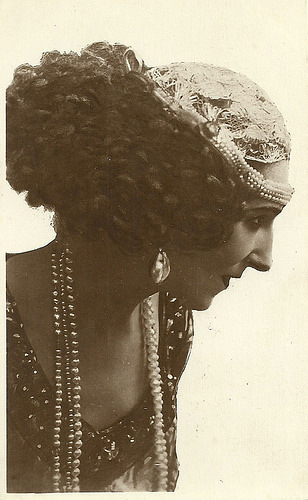
Ida Rubinstein. Italian postcard. Photo: Unione Cinematografica Italiana. Publicity still for La nave (Gabriellino D'Annunzio, Mario Roncoroni, 1921).
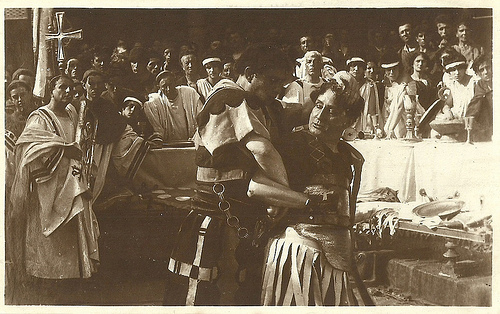
Italian postcard. Photo: Unione Cinematografica Italiana. Publicity still for La nave (Gabriellino D'Annunzio, Mario Roncoroni, 1921).
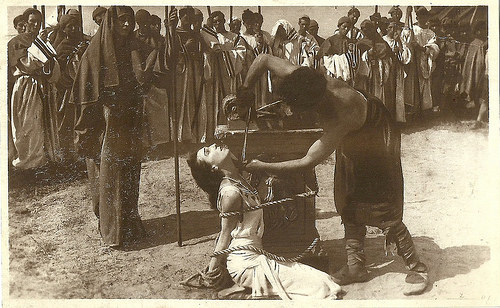
Italian postcard. Photo: Unione Cinematografica Italiana. Publicity still for La nave (Gabriellino D'Annunzio, Mario Roncoroni, 1921).
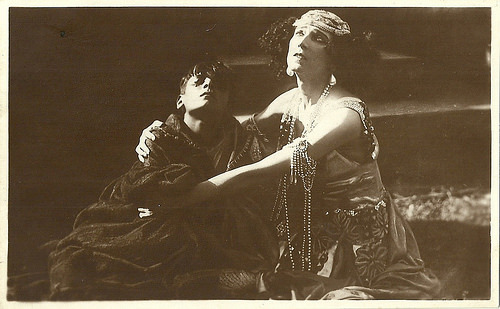
Italian postcard. Photo: Unione Cinematografica Italiana. Publicity still for La nave (Gabriellino D'Annunzio, Mario Roncoroni, 1921).
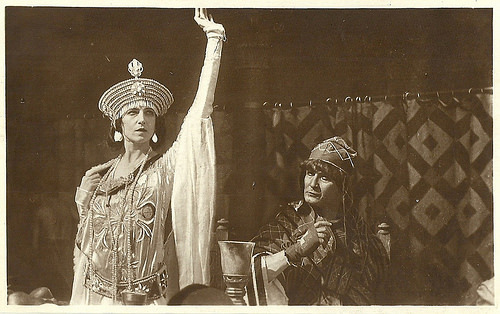
Italian postcard. Photo: Unione Cinematografica Italiana. Publicity still for La nave (Gabriellino D'Annunzio, Mario Roncoroni, 1921).
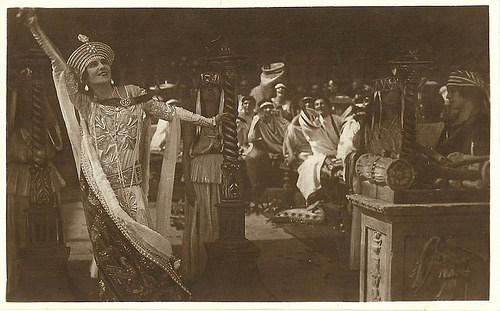
Italian postcard. Photo: Unione Cinematografica Italiana. Publicity still for La nave (Gabriellino D'Annunzio, Mario Roncoroni, 1921).
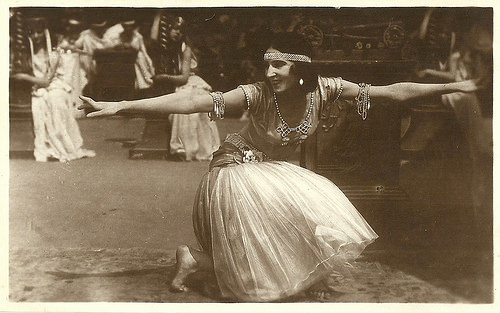
Italian postcard. Photo: Unione Cinematografica Italiana. Publicity still for La nave (Gabriellino D'Annunzio, Mario Roncoroni, 1921).
Adding cruelty and sadomasochism
Russian dancer and actress Ida Lvovna Rubinstein (1883-1960) was a close friend of the poet and playwright Gabriele D'Annunzio. Rubinstein had made her debut as Antigone before dancing in 1908 for a private performance of Oscar Wilde's Salomé in which she stripped nude for the Dance of the Seven Veils. In 1909-1911, she performed with Sergei Diaghilev's famous Ballets Russes. She danced the title role of Cléopâtre in the Paris season of 1909, and Zobéide in Scheherazade in 1910. Both exotic ballets were choreographed by Michel Fokine, and designed by Léon Bakst.
After these successes she started her own ballet company. Rubinstein staged and starred in Le Martyre de Saint-Sébastien (The Martyrdom of St. Sebastian) (1911), a poetic drama by Gabriele d’Annunzio, with incidental music by Claude Debussy, choreography by Fokine, and magnificent scenery and costumes by Bakst. For Paris audiences she embodied the erotic temptation of the East, a view enhanced by her unconventional private life, which included lovers of both sexes and posing nude for painters.
In 1921, Rubinstein played the lead of Basiliola in the film La nave/The Ship, directed by D'Annunzio's son Gabriellino and by Mario Roncoroni. The film was based on a play by D'Annunzio, which already had been turned into an opera and had been filmed in 1912 by the company Ambrosio, but without much success.
Guido Marussig, who had designed both the play and the opera, designed sets and costumes for the 1921 film. The directors shot the film in a style typical or the later silent epics in Italy, denying innovation in film language. Instead they focused on acting, set and costume design, harking back to earlier epics such as Cabiria, but adding cruelty and sadomasochism.
La nave is set in early medieval times. In the Venetian plains, at the town of Aquileia, Basiliola, daughter of the dethroned tribune Orso Faledro returns per ship and notices her father and brothers have been blinded by the Graticò brothers, of whom Marco (Alfredo Boccolini) is the new tribune and Sergio (Ciro Galvani) has become bishop.
Basiliola decides to ruin all involved. In an extended dance scene she seduces Sergio, the lecherous bishop. La nave contains the only moving images of Rubinstein dancing, and the dance scene owes a great deal to Wilde's and Strauss's' Salome.
Basiliola manages to have the soldiers arrested who were responsible for blinding her relatives. Through her femme fatale behaviour the men, locked in a pit, desire to be killed by her bow and arrows. She also manages to set up the brothers against each other, with the younger brother Marco killing his older brother Sergio. Marco, though, realises the danger of the temptress Basiliola and condemns her to be blinded too. After her death the whole community leaves by ship to escape the nearing barbarians and to found a new, Christian community on a nearby island, Venice.
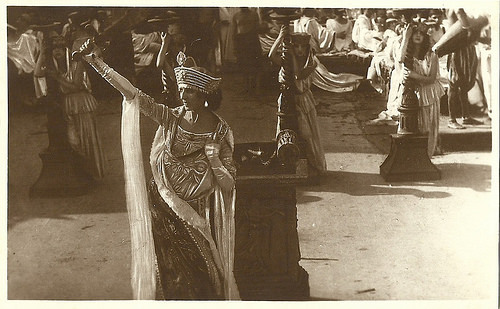
Italian postcard. Photo: Unione Cinematografica Italiana. Publicity still for La nave (Gabriellino D'Annunzio, Mario Roncoroni, 1921).
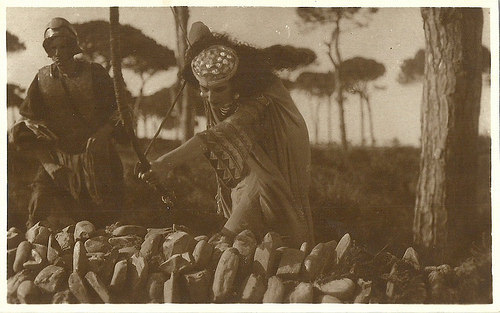
Italian postcard. Photo: Unione Cinematografica Italiana. Publicity still for La nave (Gabriellino D'Annunzio, Mario Roncoroni, 1921).
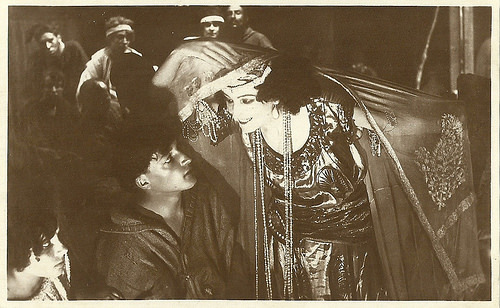
Italian postcard. Photo: Unione Cinematografica Italiana. Publicity still for La nave (Gabriellino D'Annunzio, Mario Roncoroni, 1921).
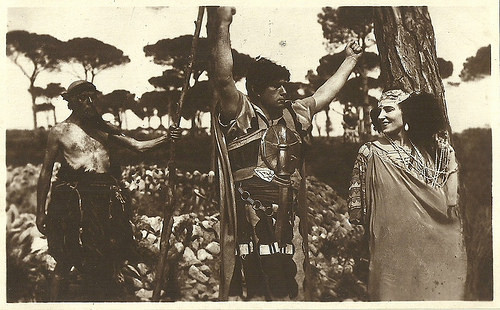
Italian postcard. Photo: Unione Cinematografica Italiana. Publicity still for La nave (Gabriellino D'Annunzio, Mario Roncoroni, 1921).
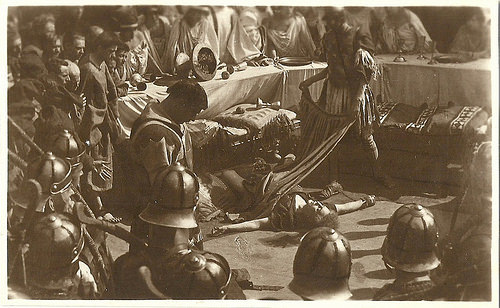
Italian postcard. Photo: Unione Cinematografica Italiana. Publicity still for La nave (Gabriellino D'Annunzio, Mario Roncoroni, 1921).
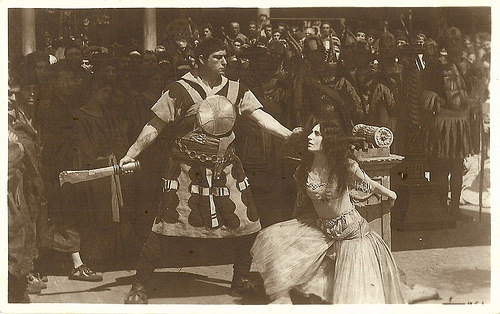
Italian postcard. Photo: Unione Cinematografica Italiana. Publicity still for La nave (Gabriellino D'Annunzio, Mario Roncoroni, 1921).
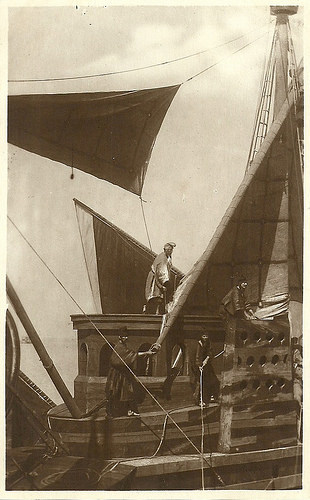
Italian postcard. Photo: Unione Cinematografica Italiana. Publicity still for La nave (Gabriellino D'Annunzio, Mario Roncoroni, 1921).
Sources: Jewish Women's Archive, Wikipedia (English and Italian), and IMDb.

Ida Rubinstein. Italian postcard. Photo: Unione Cinematografica Italiana. Publicity still for La nave (Gabriellino D'Annunzio, Mario Roncoroni, 1921).

Italian postcard. Photo: Unione Cinematografica Italiana. Publicity still for La nave (Gabriellino D'Annunzio, Mario Roncoroni, 1921).

Italian postcard. Photo: Unione Cinematografica Italiana. Publicity still for La nave (Gabriellino D'Annunzio, Mario Roncoroni, 1921).

Italian postcard. Photo: Unione Cinematografica Italiana. Publicity still for La nave (Gabriellino D'Annunzio, Mario Roncoroni, 1921).

Italian postcard. Photo: Unione Cinematografica Italiana. Publicity still for La nave (Gabriellino D'Annunzio, Mario Roncoroni, 1921).

Italian postcard. Photo: Unione Cinematografica Italiana. Publicity still for La nave (Gabriellino D'Annunzio, Mario Roncoroni, 1921).

Italian postcard. Photo: Unione Cinematografica Italiana. Publicity still for La nave (Gabriellino D'Annunzio, Mario Roncoroni, 1921).
Adding cruelty and sadomasochism
Russian dancer and actress Ida Lvovna Rubinstein (1883-1960) was a close friend of the poet and playwright Gabriele D'Annunzio. Rubinstein had made her debut as Antigone before dancing in 1908 for a private performance of Oscar Wilde's Salomé in which she stripped nude for the Dance of the Seven Veils. In 1909-1911, she performed with Sergei Diaghilev's famous Ballets Russes. She danced the title role of Cléopâtre in the Paris season of 1909, and Zobéide in Scheherazade in 1910. Both exotic ballets were choreographed by Michel Fokine, and designed by Léon Bakst.
After these successes she started her own ballet company. Rubinstein staged and starred in Le Martyre de Saint-Sébastien (The Martyrdom of St. Sebastian) (1911), a poetic drama by Gabriele d’Annunzio, with incidental music by Claude Debussy, choreography by Fokine, and magnificent scenery and costumes by Bakst. For Paris audiences she embodied the erotic temptation of the East, a view enhanced by her unconventional private life, which included lovers of both sexes and posing nude for painters.
In 1921, Rubinstein played the lead of Basiliola in the film La nave/The Ship, directed by D'Annunzio's son Gabriellino and by Mario Roncoroni. The film was based on a play by D'Annunzio, which already had been turned into an opera and had been filmed in 1912 by the company Ambrosio, but without much success.
Guido Marussig, who had designed both the play and the opera, designed sets and costumes for the 1921 film. The directors shot the film in a style typical or the later silent epics in Italy, denying innovation in film language. Instead they focused on acting, set and costume design, harking back to earlier epics such as Cabiria, but adding cruelty and sadomasochism.
La nave is set in early medieval times. In the Venetian plains, at the town of Aquileia, Basiliola, daughter of the dethroned tribune Orso Faledro returns per ship and notices her father and brothers have been blinded by the Graticò brothers, of whom Marco (Alfredo Boccolini) is the new tribune and Sergio (Ciro Galvani) has become bishop.
Basiliola decides to ruin all involved. In an extended dance scene she seduces Sergio, the lecherous bishop. La nave contains the only moving images of Rubinstein dancing, and the dance scene owes a great deal to Wilde's and Strauss's' Salome.
Basiliola manages to have the soldiers arrested who were responsible for blinding her relatives. Through her femme fatale behaviour the men, locked in a pit, desire to be killed by her bow and arrows. She also manages to set up the brothers against each other, with the younger brother Marco killing his older brother Sergio. Marco, though, realises the danger of the temptress Basiliola and condemns her to be blinded too. After her death the whole community leaves by ship to escape the nearing barbarians and to found a new, Christian community on a nearby island, Venice.

Italian postcard. Photo: Unione Cinematografica Italiana. Publicity still for La nave (Gabriellino D'Annunzio, Mario Roncoroni, 1921).

Italian postcard. Photo: Unione Cinematografica Italiana. Publicity still for La nave (Gabriellino D'Annunzio, Mario Roncoroni, 1921).

Italian postcard. Photo: Unione Cinematografica Italiana. Publicity still for La nave (Gabriellino D'Annunzio, Mario Roncoroni, 1921).

Italian postcard. Photo: Unione Cinematografica Italiana. Publicity still for La nave (Gabriellino D'Annunzio, Mario Roncoroni, 1921).

Italian postcard. Photo: Unione Cinematografica Italiana. Publicity still for La nave (Gabriellino D'Annunzio, Mario Roncoroni, 1921).

Italian postcard. Photo: Unione Cinematografica Italiana. Publicity still for La nave (Gabriellino D'Annunzio, Mario Roncoroni, 1921).

Italian postcard. Photo: Unione Cinematografica Italiana. Publicity still for La nave (Gabriellino D'Annunzio, Mario Roncoroni, 1921).
Sources: Jewish Women's Archive, Wikipedia (English and Italian), and IMDb.
Published on February 15, 2017 22:00
February 14, 2017
David Anderson's 12 Favourite European Films - after 1960
One of the finest online places to read original and always well-written reviews of old and new films is Bunched Undies. On 1 February this year, host David Anderson selected especially for EFSP twelve of his favourite European films, which were all produced before for 1960. And of course, we also wanted to know what he liked after 1960. So click on the film titles below for David's reviews of the films. The postcards all come from Truus, Bob & Jan Too! at Flickr, and the video clips from YouTube.
Red Desert (1964)
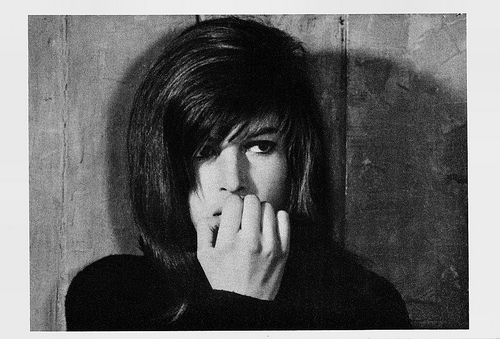
French postcard by Editions La Malibran, Paris, no CI 3. Photo: Carlo di Palma. Publicity still for Il desero rosso/Red Desert (Michelangelo Antonioni, 1964).
David Anderson: “Presented as a succession of set pieces, the film begins with a dazed Monica Vitti wandering along the perimeter of a gigantic power plant. Accompanied by her son (Valerio Bartoleschi), Vitti trudges through a toxic and barren landscape.”
The Battle of Algiers (1966)
Scene from La battaglia di Algeri/The Battle Of Algiers (Gillo Pontecorvo, 1966). Source: Gahru Mar (YouTube).
“When a group of disaffected young men led by Ali (Brahim Hadjadj) begin a series of random shootings of police officers, their campaign of terror rapidly escalates. Eventually, a highly decorated French colonel with a reputation for ruthlessness (Jean Martin) is brought in the quell the violence, and all hell breaks loose.”
Kes (1969)
Scene from Kes (Ken Loach, 1969). Source: JoeDnufc4life (YouTube).
“Kes is short for kestrel, a type of falcon common in the UK, and out of the blighted potty-mouth of young Billy Casper (David Bradley), it’s a term of endearment in this story of an unlikely friendship between a bird of prey and a victim of industrial society.”
The Spirit of the Beehive (1973)
Trailer for El espíritu de la colmena/The Spirit of the Beehive (Victor Erice, 1973). Source: Robert Marshall (YouTube).
“One day a battered delivery van arrives at the town’s makeshift cinema bearing a print of Frankenstein, James Whale’s monster epic from 1931. Among the excited villagers in attendance are seven year-old Ana (Ana Torrent) and her sister Isabel (Isabel Telleria). But what should be an evening’s light entertainment has a profound effect on young Ana, eventually leading her to an existential crisis.”
Family Nest (1979)
Scene from Családi tűzfésze/Family Nest (Bela Tarr, 1979). Source: Mulhollnd (YouTube).
“Family patriarch Gabor Kun – in an amazing performance – holds court at his family’s tiny kitchen table, and loudly issues ill-formed opinions on everything from the virtues of watery soup to the deficient child rearing abilities of his long suffering daughter-in-law Irén (Laszlone Horvath). “
Stalker (1979)
Trailer for Сталкер/Stalker (1979). Source: bioreflex (YouTube).
“With access to the Zone forbidden by the authorities, shadowy men known as Stalkers act as guides for those with the determination - and the money - to risk an expedition into this secret Shangri-La. With a writer (Anatoliy Solonitsyn) and a professor (Nikolay Grinko) in tow, one such grim faced Stalker (Aleksandr Kaydanovskiy) heads out on a drizzly dawn to lead a furtive walk into the unknown.”
Pauline at the Beach (1983)
[image error]
Arielle Dombasle. French postcard by Equilibres et Populations, Paris. Photo: Jean-Daniel Lorieux, 2003.
“Eric Rohmer's commentary on the perils of summer romances starts with the opening of a gate, as recent divorcee Marion (Arielle Dombasle) and her 14 year old cousin Pauline (Amanda Langlet) escape Paris for a brief holiday - brief by French standards anyway - at the shore near Mont Saint-Michelle.”
My Life as a Dog (1985)
Trailer Mitt liv som hund/My Life as a Dog (Lasse Halström, 1985). Source: Blondinka Inoz (YouTube).
“When Ingmar’s mother is stricken with tuberculosis, he is sent to the rural community of Emmaboda to live with his lively and eccentric uncle (Tomas von Brömssen). For one magical summer, amid a gallimaufry of rustic goofballs, Ingemar rediscovers the joys of childhood and thanks to a budding - in all senses of the word - tomboy named Saga (Melinda Kinnaman), he learns that growing up has its advantages too.”
Jean de Florette (1986)
[image error]
Yves Montand . German postcard by Krüger, no. 902/394. Photo: Gerard Decaux.
“Claude Berri’s Jean de Florette is part one of a sprawling Shakespearean-style tragedy; a multi-generational tale of parched, flinty soils and equally barren human souls. Set in the blinding sunlight of Provence circa 1920, it’s the story of the last surviving members of the Sobeyran family ( Yves Montand , Daniel Auteuil), a once flourishing clan laid low by decades of petty squabbles and shady dealings.”
Babette's Feast (1987)

Stephane Audran. French postcard by St. Anne, Marseille. Photo: Sam Lévin.
“Like all good fairy tales, Babette’s Feast has a moral. Actually it has several morals, some obvious, some buried in subtext. It’s an example of film as palimpsest; charming and engaging on its rustic surface, but laden with deep veins of meaning and nuggets of existential truth for those willing to unearth them.”
The Double Life of Veronique (1991)
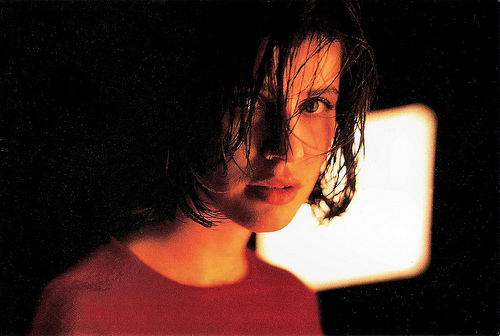
Irene Jacob. British postcard by Articificial Eye for the video release of |Trois couleurs: Rouge/Three Colours Red (Krzysztof Kieslowski, 1994).
Appropriately, The Double Life of Veronique is actually two films in one. The first act deals with a young woman in Poland (Irene Jacob) who has just gotten a big break in her fledgling career as a classical singer. One day on the cobblestone streets of Krakow, she spots a French tourist (Jacob in a double role) who could be her identical twin, setting off a chain of heartbreaking events.
I Can No Longer Hear the Guitar (1991)
Scene from J'entends plus la guitare/I Can No Longer Hear the Guitar (Philippe Garrel, 1991). Source: Boris Varissa (YouTube).
“Gerard (Benoit Regent) is completely captivated by Marianne (Johanna ter Steege) who is beautiful, bewitching and 100 lbs. of trouble. Since neither one really trusts the notion of happiness, their brief interludes of domestic bliss cause a slow-simmering panic in each of them, because, to paraphrase their friend Martin (Yann Collette): the worst part of happiness is being afraid you’ll lose it.”
Rosetta (1999)
[image error]
Belgian postcard by Ed. resp. P. Hurbain, Bruxelles, no. 148. Photo: Laurent Rebours / AP. Caption: Cannes 1999: Rosetta, the film by the Dardenne brothers, receives the Grand Prix, and Émilie Dequenne wins the award for Best Actress.
“Dequenne won the best actress award at Cannes for this performance, and her ability to lose herself in the film’s swirling maelstrom, usually with a camera lens just inches from her face, required confidence and skill far beyond her years. Her stunning work in Rosetta is nothing short of a revelation.”
Great, interesting choices! David, thank you very much.
Red Desert (1964)

French postcard by Editions La Malibran, Paris, no CI 3. Photo: Carlo di Palma. Publicity still for Il desero rosso/Red Desert (Michelangelo Antonioni, 1964).
David Anderson: “Presented as a succession of set pieces, the film begins with a dazed Monica Vitti wandering along the perimeter of a gigantic power plant. Accompanied by her son (Valerio Bartoleschi), Vitti trudges through a toxic and barren landscape.”
The Battle of Algiers (1966)
Scene from La battaglia di Algeri/The Battle Of Algiers (Gillo Pontecorvo, 1966). Source: Gahru Mar (YouTube).
“When a group of disaffected young men led by Ali (Brahim Hadjadj) begin a series of random shootings of police officers, their campaign of terror rapidly escalates. Eventually, a highly decorated French colonel with a reputation for ruthlessness (Jean Martin) is brought in the quell the violence, and all hell breaks loose.”
Kes (1969)
Scene from Kes (Ken Loach, 1969). Source: JoeDnufc4life (YouTube).
“Kes is short for kestrel, a type of falcon common in the UK, and out of the blighted potty-mouth of young Billy Casper (David Bradley), it’s a term of endearment in this story of an unlikely friendship between a bird of prey and a victim of industrial society.”
The Spirit of the Beehive (1973)
Trailer for El espíritu de la colmena/The Spirit of the Beehive (Victor Erice, 1973). Source: Robert Marshall (YouTube).
“One day a battered delivery van arrives at the town’s makeshift cinema bearing a print of Frankenstein, James Whale’s monster epic from 1931. Among the excited villagers in attendance are seven year-old Ana (Ana Torrent) and her sister Isabel (Isabel Telleria). But what should be an evening’s light entertainment has a profound effect on young Ana, eventually leading her to an existential crisis.”
Family Nest (1979)
Scene from Családi tűzfésze/Family Nest (Bela Tarr, 1979). Source: Mulhollnd (YouTube).
“Family patriarch Gabor Kun – in an amazing performance – holds court at his family’s tiny kitchen table, and loudly issues ill-formed opinions on everything from the virtues of watery soup to the deficient child rearing abilities of his long suffering daughter-in-law Irén (Laszlone Horvath). “
Stalker (1979)
Trailer for Сталкер/Stalker (1979). Source: bioreflex (YouTube).
“With access to the Zone forbidden by the authorities, shadowy men known as Stalkers act as guides for those with the determination - and the money - to risk an expedition into this secret Shangri-La. With a writer (Anatoliy Solonitsyn) and a professor (Nikolay Grinko) in tow, one such grim faced Stalker (Aleksandr Kaydanovskiy) heads out on a drizzly dawn to lead a furtive walk into the unknown.”
Pauline at the Beach (1983)
[image error]
Arielle Dombasle. French postcard by Equilibres et Populations, Paris. Photo: Jean-Daniel Lorieux, 2003.
“Eric Rohmer's commentary on the perils of summer romances starts with the opening of a gate, as recent divorcee Marion (Arielle Dombasle) and her 14 year old cousin Pauline (Amanda Langlet) escape Paris for a brief holiday - brief by French standards anyway - at the shore near Mont Saint-Michelle.”
My Life as a Dog (1985)
Trailer Mitt liv som hund/My Life as a Dog (Lasse Halström, 1985). Source: Blondinka Inoz (YouTube).
“When Ingmar’s mother is stricken with tuberculosis, he is sent to the rural community of Emmaboda to live with his lively and eccentric uncle (Tomas von Brömssen). For one magical summer, amid a gallimaufry of rustic goofballs, Ingemar rediscovers the joys of childhood and thanks to a budding - in all senses of the word - tomboy named Saga (Melinda Kinnaman), he learns that growing up has its advantages too.”
Jean de Florette (1986)
[image error]
Yves Montand . German postcard by Krüger, no. 902/394. Photo: Gerard Decaux.
“Claude Berri’s Jean de Florette is part one of a sprawling Shakespearean-style tragedy; a multi-generational tale of parched, flinty soils and equally barren human souls. Set in the blinding sunlight of Provence circa 1920, it’s the story of the last surviving members of the Sobeyran family ( Yves Montand , Daniel Auteuil), a once flourishing clan laid low by decades of petty squabbles and shady dealings.”
Babette's Feast (1987)

Stephane Audran. French postcard by St. Anne, Marseille. Photo: Sam Lévin.
“Like all good fairy tales, Babette’s Feast has a moral. Actually it has several morals, some obvious, some buried in subtext. It’s an example of film as palimpsest; charming and engaging on its rustic surface, but laden with deep veins of meaning and nuggets of existential truth for those willing to unearth them.”
The Double Life of Veronique (1991)

Irene Jacob. British postcard by Articificial Eye for the video release of |Trois couleurs: Rouge/Three Colours Red (Krzysztof Kieslowski, 1994).
Appropriately, The Double Life of Veronique is actually two films in one. The first act deals with a young woman in Poland (Irene Jacob) who has just gotten a big break in her fledgling career as a classical singer. One day on the cobblestone streets of Krakow, she spots a French tourist (Jacob in a double role) who could be her identical twin, setting off a chain of heartbreaking events.
I Can No Longer Hear the Guitar (1991)
Scene from J'entends plus la guitare/I Can No Longer Hear the Guitar (Philippe Garrel, 1991). Source: Boris Varissa (YouTube).
“Gerard (Benoit Regent) is completely captivated by Marianne (Johanna ter Steege) who is beautiful, bewitching and 100 lbs. of trouble. Since neither one really trusts the notion of happiness, their brief interludes of domestic bliss cause a slow-simmering panic in each of them, because, to paraphrase their friend Martin (Yann Collette): the worst part of happiness is being afraid you’ll lose it.”
Rosetta (1999)
[image error]
Belgian postcard by Ed. resp. P. Hurbain, Bruxelles, no. 148. Photo: Laurent Rebours / AP. Caption: Cannes 1999: Rosetta, the film by the Dardenne brothers, receives the Grand Prix, and Émilie Dequenne wins the award for Best Actress.
“Dequenne won the best actress award at Cannes for this performance, and her ability to lose herself in the film’s swirling maelstrom, usually with a camera lens just inches from her face, required confidence and skill far beyond her years. Her stunning work in Rosetta is nothing short of a revelation.”
Great, interesting choices! David, thank you very much.
Published on February 14, 2017 22:00
February 13, 2017
Happy Valentine's Day!
Is Valentine's Day grossly commercialised? We guess so, but not here. EFSP is for lovers, not for ads. So let's get crazy with 12 postcards full of hearts, kisses and amour, amore, liebe, karlek, liefde... You can't have enough of that.
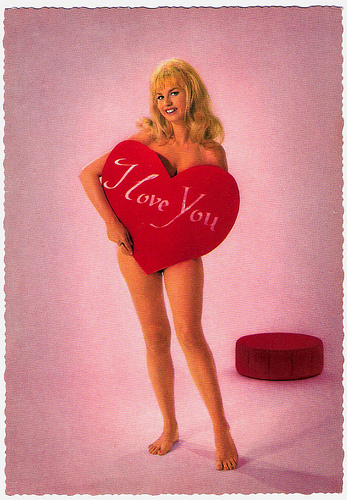
German Postcard by Krüger, no. 900/272.
Film and TV actress Barbara Valentin (1940-2002) was dubbed the 'German Jayne Mansfield' and a 'Scandal Magnet'. Her résumé includes sexploitation but also art films directed by Rainer Werner Fassbinder. Her private life was fodder for the tabloids. Pop star Freddie Mercury was ‘the love of her life’.
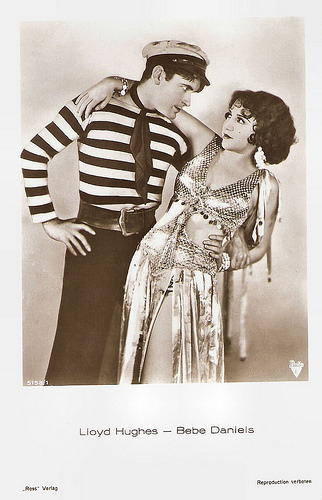
German postcard by Ross Verlag, no. 5158/1, 1930-1931. Photo: Radio Pictures (RKO). Publicity still for Love Comes Along (Rupert Julian, 1930) with Lloyd Hughes and Bebe Daniels .
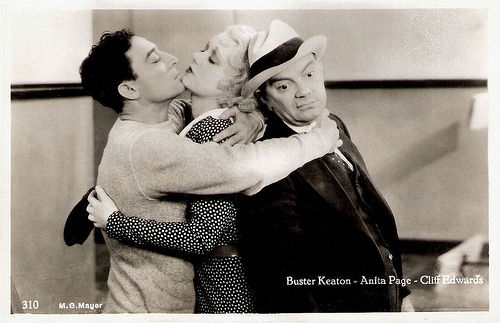
Dutch postcard by JosPe, no. 310. Photo: Metro-Goldwyn-Mayer (MGM). Publicity still for Sidewalks of New York (Zion Myers, Jules White, 1931) with Buster Keaton , Anita Page and Cliff Edwards.
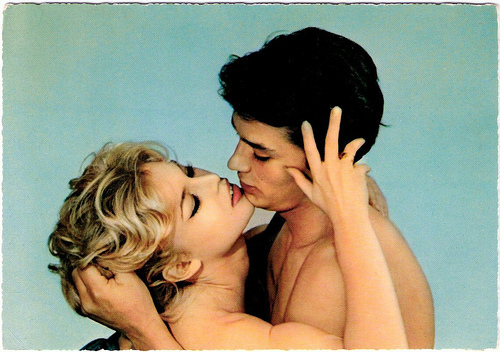
German postcard by Krüger, no. 902/95. 1961. Photo: Sam Lévin. Publicity still for the anthology film Amours célèbres/Famous Love Affairs (Michel Boisrond, 1961). Alain Delon and Brigitte Bardot starred in the segment Agnès Bernauer.
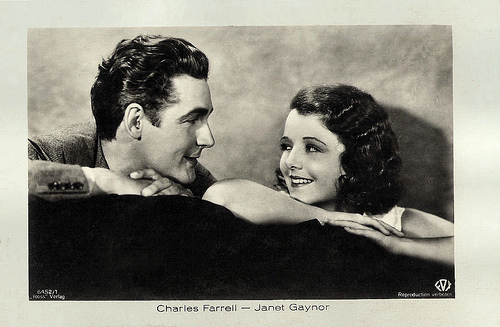
German postcard by Ross Verlag, no 6452/1, 1931-1932. Photo: Fox. Publicity still for Delicious (David Butler, 1931) with Charles Farrell and Janet Gaynor.
[image error]
German postcard by Photochemie, Berlin, no. K.2823. Photo: Sommer Film, Berlin.
Ernst Matráy (1891-1978) was a Hungarian dancer, choreographer, actor and film director. In Berlin, he worked with Max Reinhardt and Ernst Lubitsch. With his sister-in-law, Katta Sterna, he formed an ideal film couple. Together with his wife, Maria Solveg, he later did the choreography for some classic Hollywood films.
Weddings for soldiers who were forbidden to marry
St. Valentine's Day began as a liturgical celebration of one or more early Christian saints named Valentinus. Several martyrdom stories were invented for the various Valentines that belonged to 14 February.
A popular hagiographical account of Saint Valentine of Rome states that he was imprisoned for performing weddings for soldiers who were forbidden to marry and for ministering to Christians, who were persecuted under the Roman Empire.
According to legend, during his imprisonment, he healed the daughter of his jailer, Asterius. An embellishment to this story states that before his execution he wrote her a letter signed "Your Valentine" as a farewell.
Today, Saint Valentine's Day is an official feast day in the Anglican Communion, as well as in the Lutheran Church. The day was first associated with romantic love in the circle of Geoffrey Chaucer in the High Middle Ages, when the tradition of courtly love flourished.
In 18th-century England, it evolved into an occasion in which lovers expressed their love for each other by presenting flowers, offering confectionery, and sending greeting cards known as 'valentines'.
Valentine's Day symbols that are used today include the heart-shaped outline, doves, and the figure of the winged Cupid. Since the 19th century, handwritten valentines have given way to mass-produced greeting cards.
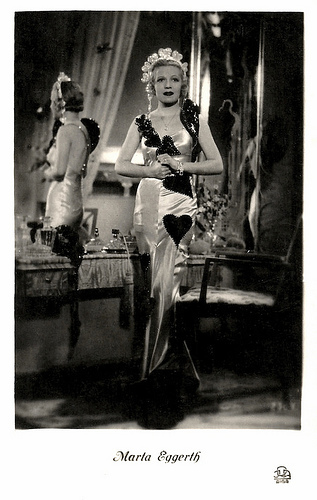
Latvian postcard by JUR, Riga.
Hungarian-born singer and actress Márta Eggerth (1912-2013) maintained a global career for over 70 years. She was the popular and talented star of 30 German and Austrian operetta films of the 1930s. Many of the 20th century's most famous operetta composers, including Franz Lehár, Fritz Kreisler, Robert Stolz, Oscar Straus, and Paul Abraham, composed works especially for her. After the rise of the Nazis, she continued her career in the US, together with the love of her life, tenor Jan Kiepura.
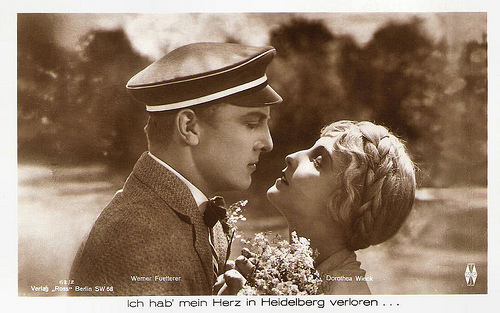
German postcard by Ross Verlag, Berlin, no. 61/2, 1926. Photo: Münchner Lichtspielkunst AG (Emelka). Publicity still for Ich hab mein Herz in Heidelberg verloren/I Lost My Heart in Heidelberg (Arthur Bergen, 1926) with Werner Fuetterer and Dorothea Wieck .
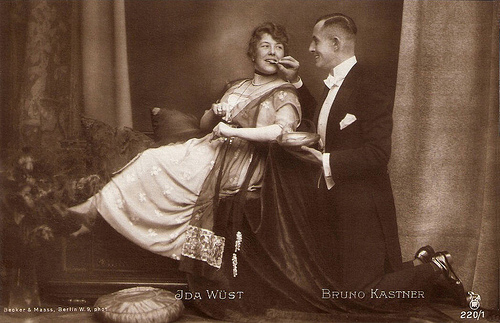
German postcard by Rotophot, no. 220/1. Photo: Becker & Maass, Berlin.
German actress Ida Wüst (1884-1956) was a Ufa star who appeared in almost 150 films. In the 1930s she became one of the most popular aunts of the German cinema. Her one-time husband, German actor Bruno Kastner (1890-1932) was one of the most beloved stars of the 1910s and 1920s. His parts as the elegant and charming dandy made him a heart throb of the German silent cinema.
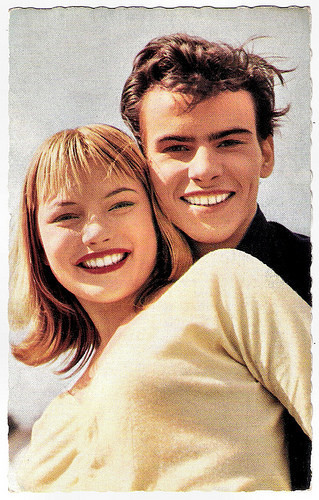
Austrian postcard by Lichtbild-Vertrieb Paula Weizmann, Wien, no. F 7. Photo: Interwest / Union-Film / Haenchen. Publicity still for Die Halbstarken/Teenage Wolfpack (Georg Tressler, 1956) with Karin Baal and Horst Buchholz .
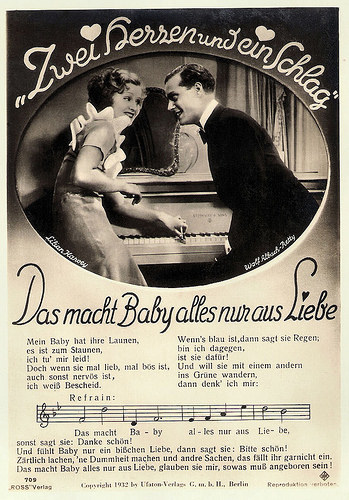
German postcard by Ross Verlag, no. 709. Photo: Ufa. Publicity still for Zwei Herzen und ein Schlag/Two Hearts Beat as One (Wilhelm Thiele, 1932) with Lilian Harvey and Wolf Albach-Retty . Collection: Egbert Barten.
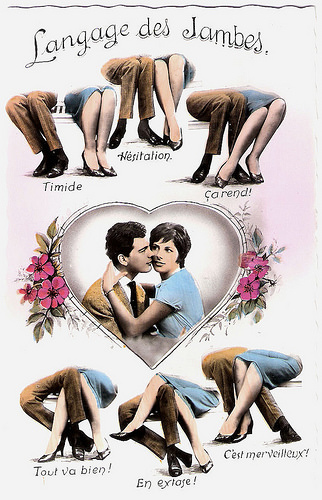
French postcard by Editions De Luxe G.P., Paris, no. 378.
This is a post for everyone with a heart, and especially for Ivo .

German Postcard by Krüger, no. 900/272.
Film and TV actress Barbara Valentin (1940-2002) was dubbed the 'German Jayne Mansfield' and a 'Scandal Magnet'. Her résumé includes sexploitation but also art films directed by Rainer Werner Fassbinder. Her private life was fodder for the tabloids. Pop star Freddie Mercury was ‘the love of her life’.

German postcard by Ross Verlag, no. 5158/1, 1930-1931. Photo: Radio Pictures (RKO). Publicity still for Love Comes Along (Rupert Julian, 1930) with Lloyd Hughes and Bebe Daniels .

Dutch postcard by JosPe, no. 310. Photo: Metro-Goldwyn-Mayer (MGM). Publicity still for Sidewalks of New York (Zion Myers, Jules White, 1931) with Buster Keaton , Anita Page and Cliff Edwards.

German postcard by Krüger, no. 902/95. 1961. Photo: Sam Lévin. Publicity still for the anthology film Amours célèbres/Famous Love Affairs (Michel Boisrond, 1961). Alain Delon and Brigitte Bardot starred in the segment Agnès Bernauer.

German postcard by Ross Verlag, no 6452/1, 1931-1932. Photo: Fox. Publicity still for Delicious (David Butler, 1931) with Charles Farrell and Janet Gaynor.
[image error]
German postcard by Photochemie, Berlin, no. K.2823. Photo: Sommer Film, Berlin.
Ernst Matráy (1891-1978) was a Hungarian dancer, choreographer, actor and film director. In Berlin, he worked with Max Reinhardt and Ernst Lubitsch. With his sister-in-law, Katta Sterna, he formed an ideal film couple. Together with his wife, Maria Solveg, he later did the choreography for some classic Hollywood films.
Weddings for soldiers who were forbidden to marry
St. Valentine's Day began as a liturgical celebration of one or more early Christian saints named Valentinus. Several martyrdom stories were invented for the various Valentines that belonged to 14 February.
A popular hagiographical account of Saint Valentine of Rome states that he was imprisoned for performing weddings for soldiers who were forbidden to marry and for ministering to Christians, who were persecuted under the Roman Empire.
According to legend, during his imprisonment, he healed the daughter of his jailer, Asterius. An embellishment to this story states that before his execution he wrote her a letter signed "Your Valentine" as a farewell.
Today, Saint Valentine's Day is an official feast day in the Anglican Communion, as well as in the Lutheran Church. The day was first associated with romantic love in the circle of Geoffrey Chaucer in the High Middle Ages, when the tradition of courtly love flourished.
In 18th-century England, it evolved into an occasion in which lovers expressed their love for each other by presenting flowers, offering confectionery, and sending greeting cards known as 'valentines'.
Valentine's Day symbols that are used today include the heart-shaped outline, doves, and the figure of the winged Cupid. Since the 19th century, handwritten valentines have given way to mass-produced greeting cards.

Latvian postcard by JUR, Riga.
Hungarian-born singer and actress Márta Eggerth (1912-2013) maintained a global career for over 70 years. She was the popular and talented star of 30 German and Austrian operetta films of the 1930s. Many of the 20th century's most famous operetta composers, including Franz Lehár, Fritz Kreisler, Robert Stolz, Oscar Straus, and Paul Abraham, composed works especially for her. After the rise of the Nazis, she continued her career in the US, together with the love of her life, tenor Jan Kiepura.

German postcard by Ross Verlag, Berlin, no. 61/2, 1926. Photo: Münchner Lichtspielkunst AG (Emelka). Publicity still for Ich hab mein Herz in Heidelberg verloren/I Lost My Heart in Heidelberg (Arthur Bergen, 1926) with Werner Fuetterer and Dorothea Wieck .

German postcard by Rotophot, no. 220/1. Photo: Becker & Maass, Berlin.
German actress Ida Wüst (1884-1956) was a Ufa star who appeared in almost 150 films. In the 1930s she became one of the most popular aunts of the German cinema. Her one-time husband, German actor Bruno Kastner (1890-1932) was one of the most beloved stars of the 1910s and 1920s. His parts as the elegant and charming dandy made him a heart throb of the German silent cinema.

Austrian postcard by Lichtbild-Vertrieb Paula Weizmann, Wien, no. F 7. Photo: Interwest / Union-Film / Haenchen. Publicity still for Die Halbstarken/Teenage Wolfpack (Georg Tressler, 1956) with Karin Baal and Horst Buchholz .

German postcard by Ross Verlag, no. 709. Photo: Ufa. Publicity still for Zwei Herzen und ein Schlag/Two Hearts Beat as One (Wilhelm Thiele, 1932) with Lilian Harvey and Wolf Albach-Retty . Collection: Egbert Barten.

French postcard by Editions De Luxe G.P., Paris, no. 378.
This is a post for everyone with a heart, and especially for Ivo .
Published on February 13, 2017 22:00
Paul van Yperen's Blog
- Paul van Yperen's profile
- 13 followers
Paul van Yperen isn't a Goodreads Author
(yet),
but they
do have a blog,
so here are some recent posts imported from
their feed.



